The leading innovator supplying cutting-edge integrity solutions. Together we can ensure sustainable decision-making. Our combination of advanced inspection systems and expert consultants delivers a comprehensive understanding of asset safety, lifetime, and performance.
Comprehensive Asset Integrity Management

WORLD PIPELINES | VOLUME 23 | NUMBER 9 | SEPTEMBER 2023
03. Guest comment
Thure Cannon, President, Texas Pipeline Association (TPA).
05. Editor's comment
07. Pipeline news
With news from PHMSA, TC Energy, Cheniere Energy, Wood and Vallourec.
KEYNOTE ARTICLES: AUTOMATION TECHNOLOGY
09. Maintaining control
Thony Brito, Sensia Global, UAE, discusses the value of modernising oil and gas operations with a smart pipeline strategy.
13. A new data-driven paradigm

Jochen Apel, Head of Digital Industries, Nokia, explores how converged field automation networks support the digitalisation of oil and gas.
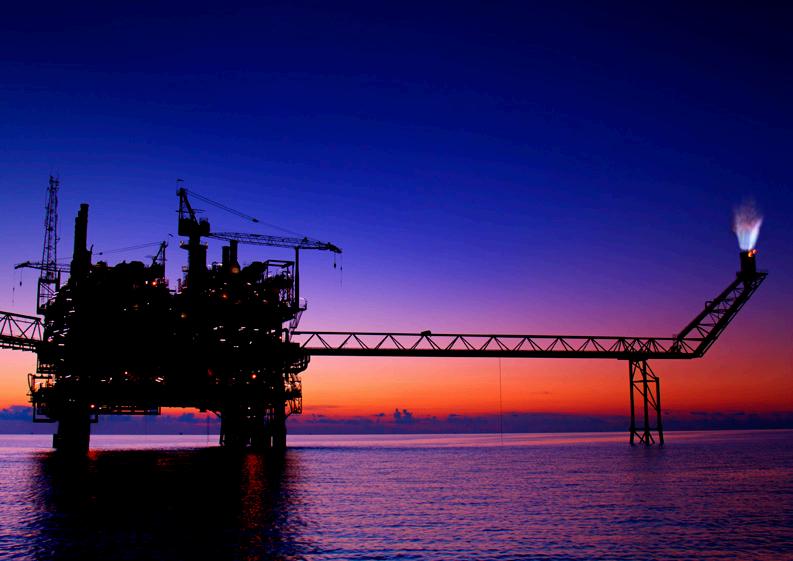
18. Automate to produce process insights
Using advanced analytics solutions, pipeline operators can automate data aggregation and cleansing, speed up process insights, and increase shareability among teams, says Morgan Bowling, Industry Principal, Seeq Corporation, USA.


LAUNCHING AND RECEIVING PIGS
43. Successful launching and receiving Simon Bell, iNPIPE PRODUCTS, UK.
DEEPWATER PIPELINE ENGINEERING

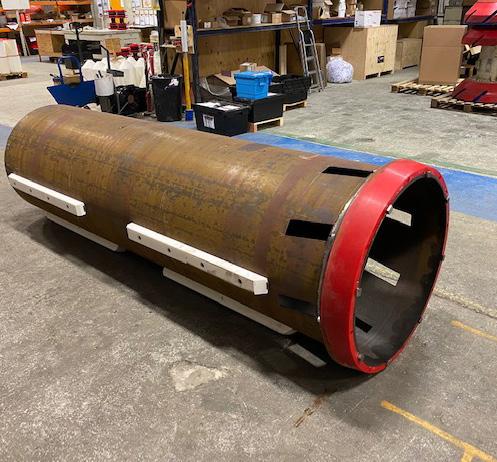
48. Real-time offshore data
Jim Bramlett, Commercial Manager, Tracerco, the Americas.
CORROSION CONTROL AND CONDITION ASSESSMENT
23. The changing market landscape
François Lachance Eng MBA, Product Manager, CREAFORM, Canada.
NORTH AMERICAN PIPELINES
28. Taking North America's temperature
Contributing Editor, Gordon Cope.
33. Expanding horizons
Lee Williams, Senior Research Analyst, Wood Mackenzie, USA.
37. Advanced analytics in North America

Keila Caridad, Aaron Schartner, and Vincent Tse, TC Energy, and Melissa Gurney, Scott Miller, Samaneh Sadeghi and Stuart Clouston, Baker Hughes.
HYDROGEN PIPELINES
52. Net-zero ambitions
Pipeline Industries Guild’s Net Zero Transition Panel.
CBP019982
With more than 60 years of experience, Seal For Life Industries offers the most diversified coating solutions in the market for superior infrastructure protection. Seal For Life is made up of 14 distinct brands offering products from self-healing coatings to heat-shrink sleeves, anti-corrosion tapes to liquid epoxy coatings, cathodic protection to intumescent coatings, polymer floorings to pipeline logistic solutions; all servicing multiple industries across the globe.
GUEST COMMENT T
exas is now the second most populous state in the US, gaining an average of 412 958 residents annually between 2000 and 2022 for a total population of 30 029 572. The growth has been startlingly rapid: in 2010, Texas’ population was just two-thirds that of California. By 2022, it was more than threefourths of the nation’s most populus state.
and US$377 000 in cumulative property tax revenues generated per mile of a pipeline for a typical Texas county.
In addition to fueling our homes, businesses and the economy, pipelines are the safest, most reliable, efficient and economic means of transporting large quantities of natural gas, crude and refined petroleum products.
more industry commentary,
In addition to the population growth, Texas is now home to a rapidly growing number of energy-intense businesses. In 2021, 62 corporations relocated their headquarters here to take advantage of the state’s abundant supply of natural gas, the nation’s largest and most integrated pipeline infrastructure network and the state’s adherence to competitive, free-market principles in private business dealings.
Not only does the pipeline industry transport the vital natural gas, crude oil and numerous other hydrocarbon products that are utilised by Texans and Americans every day, but the Texas midstream industry is also an economic powerhouse.
Using pipelines to transport oil and gas also helps to protect the environment, reducing the burden on our infrastructure, in part because pipelines take tanker trucks off the road. A moderate 20 in. pipeline running 50 miles through a county can displace 1650 trucks – lessening congestion, pollution, traffic accidents and highway damage.
Texas’ 437 747 miles of intrastate pipelines are also part of a growing infrastructure that transports new, lowercarbon fuels that help to reduce emissions.
SERIES 2: SUSTAINABILITY IN THE
Episode 1
Moving hydrocarbon businesses towards something greener
Episode 2
The principles and pillars of sustainability
Episode 3
Sustainability disputes: strategies for managing risk
Episode 4
Chemistry at work: sustainability in the oilfield

According to the recently released 2022 ‘Analysis of the Current and Future Economic Impact of the Texas Oil and Gas Pipeline Industry’ study, through ongoing operations and construction in 2022 alone, the industry provided more than US$60.5 billion in economic output; more than US$34 billion in additional gross state product; nearly US$3.6 billion in state and local government revenues; more than 234 000 jobs; and an estimated US$12 250 in property tax revenues generated per mile of a pipeline for a typical Texas county.
Conducted by the Center for Energy Commerce at Texas Tech University and commissioned by the Texas Pipeline Association (TPA), the study also found that the strength of the midstream industry is expected to continue. Over the next 40 years, in today’s dollars, the pipeline industry is conservatively expected to generate cumulative economic impacts of US$1.86 trillion in economic output; US$1.05 trillion in additional gross state product; US$110.34 billion in state and local government revenues; nearly 525 000 jobs;
Lower-carbon fuels, such as biofuel, hydrogen fuel and sustainable aviation fuels (SAF), are examples of renewables that may use existing pipelines that have been repurposed. Along with these fuels, both propane and natural gas are considered lower carbon when compared with traditional alternatives. In addition, the advent of CO2 pipelines has the potential to provide additional opportunities for the Texas midstream industry.
Whichever type of hydrocarbons are being transported, pipelines are the lifeblood of the energy system. Now, more than ever, it is essential that America has the needed pipeline infrastructure to provide consumers with dependable, low-cost sources of energy and industry with the raw materials used in the production of a myriad of common household and healthcare products.

Sources
Texas Joins California as State with 30-Million-Plus Population, United States Census Bureau; 30 March 2023.
YTexas Relo Tracker Report, Tracking Corporate Relocations to Texas in 2021; May 2022.
2022 Analysis of the Current and Future Economic Impact of the Texas Oil and Gas Pipeline Industry study, Texas Tech University, Center for Energy Commerce Rawls College of Business; May 2023.
Texas Pipeline System Mileage, Railroad Commission of Texas; 2022.
 Thure Cannon
President, Texas Pipeline Association (TPA)
OIL AND GAS SECTOR
For
listen to the Palladian Energy Podcast
Thure Cannon
President, Texas Pipeline Association (TPA)
OIL AND GAS SECTOR
For
listen to the Palladian Energy Podcast
TRI-TOP FOR LNG APPLICATIONS

EDITOR’S COMMENT
CONTACT INFORMATION
MANAGING EDITOR
James Little james.little@palladianpublications.com
SALES DIRECTOR

Rod Hardy rod.hardy@palladianpublications.com
SALES MANAGER
Chris Lethbridge chris.lethbridge@palladianpublications.com
SALES EXECUTIVE
Daniel Farr daniel.farr@palladianpublications.com
PRODUCTION MANAGER
Calli Fabian calli.fabian@palladianpublications.com
EVENTS MANAGER
Louise Cameron louise.cameron@palladianpublications.com
DIGITAL EVENTS COORDINATOR
Merili Jurivete merili.jurivete@palladianpublications.com
DIGITAL ADMINISTRATOR
Leah Jones leah.jones@palladianpublications.com
ADMINISTRATION MANAGER
Laura White laura.white@palladianpublications.com
Palladian Publications Ltd, 15 South Street, Farnham, Surrey, GU9 7QU, UK
Tel: +44 (0) 1252 718 999
Website: www.worldpipelines.com
Email: enquiries@worldpipelines.com
Annual subscription £60 UK including postage/£75 overseas (postage airmail). Special two year discounted rate: £96 UK including postage/£120 overseas (postage airmail). Claims for non receipt of issues must be made within three months of publication of the issue or they will not be honoured without charge.
Applicable only to USA & Canada:
World Pipelines (ISSN No: 1472-7390, USPS No: 020-988) is published monthly by Palladian Publications Ltd, GBR and distributed in the USA by Asendia USA, 17B S Middlesex Ave, Monroe NJ 08831. Periodicals postage paid New Brunswick, NJ and additional mailing offices. POSTMASTER: send address changes to World Pipelines, 701C Ashland Ave, Folcroft PA 19032
PHMSA held a virtual press briefing towards at the beginning of August, to announce that it is launching Social Equity Mapping Tools to visualise pipeline accidents and incidents across the US. The endeavour seeks to promote data transparency, by making pipeline incident data easier to access and understand for the public. The Social Equity Mapping Tools provide a state-by-state analysis of reportable pipeline incidents and accidents, where users can view the cause of pipeline failures, the operator of that line, and the communities affected by the incident. These tools are part of DOT’s Justice40 Initiative to confront and address underinvestment in disadvantaged communities. They aim to make it easier for users to learn more about pipeline safety incidents affecting their communities.
The thinking behind this initiative is that visibility of pipeline incidents is key to highlighting the historical disparities and systemic issues that have led to underinvestment in certain communities. This is particularly relevant in those comprising marginalised and vulnerable populations. The DOT’s efforts to engage with communities via these new tools is encouraging: pipeline incidents can erode trust between communities and the companies or regulatory agencies responsible for pipeline operations. Lack of transparency and inadequate communication during, and after, incidents can lead to frustration and disillusionment. Pipeline incidents can have far-reaching consequences on the well-being, safety, and livelihoods of communities. These impacts underscore the importance of prioritising pipeline safety, implementing preventive measures, and supporting affected communities in their recovery efforts.
In our keynote section this month, we evaluate automation tools and technology for the pipeline industry, focusing on technologies and tools for making pipeline operations safer and more efficient.

Sensia Global introduces digital solutions to help pipeline operators keep product flowing safely, and to convert operational data into information and analytics. The article describes several case studies where pipeline operators needed to optimise and upgrade their systems, and were able to utilise modern smart operations to do so.
Nokia tackles the issue of bridging legacy and future automation applications, explaining that “many of today’s oil and gas operations rely on legacy network technologies such as serial interfaces used in SCADA and other industrial systems for operational controls and in-plant communications. Operations can’t afford to add another overlay network to what is already a burdensome mix of old and new network technologies.” Read the article at p.13 to find out how converged communications and field automation networks (FAN) can help.
Seeq recommends advanced analytics solutions for improved communication and sharing within pipeline teams. Everyone wants insight into their pipeline assets and data scientists spend a lot of time preparing data for analysis; Seeq describes how automated data conditioning and reporting can save time in getting valuable, actionable insights.
This month’s issue also includes a special section on North American pipelines, which includes an overview of the North American energy market (p.28); analysis of the changing midstream investment landscape (p.33); and a case study from Baker Hughes about its work with TC Energy, which embarked on a data analytics project to better define inspection tolerances, for increased measurement accuracy (p.37).
SENIOR EDITOR Elizabeth Corner elizabeth.corner@palladianpublications.comThe experts you can trust


CRC Evans’ market-leading welding, inspection and coating services, technologies and high-performance equipment ensures efficient, on-time delivery of your global onshore and offshore energy projects.
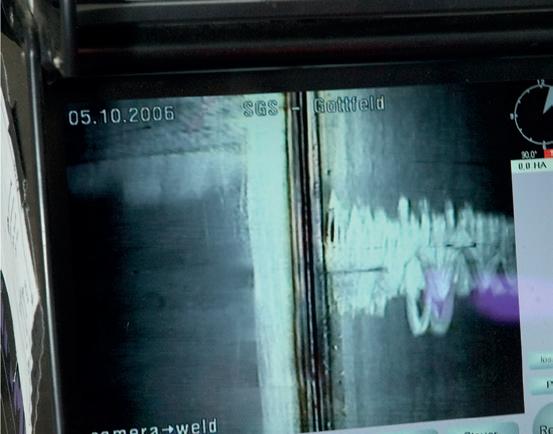



WORLD NEWS
USDOT awards US64.4 million in pipeline safety grants
The US Department of Transportation’s Pipeline and Hazardous Materials Safety Administration (PHMSA) is awarding US$64.4 million in grants to support state-pipeline and underground natural gas storage (UNGS) safety operations.
These grants provide states with resources to inspect pipelines and UNGS facilities, ensuring they are complying with federal and state regulations.
“State pipeline inspectors oversee more than 80% of our nation’s 3.4 million miles pipeline system, and we want to ensure they have the resources they need to carry out their vital work,” said US Transportation Secretary Pete Buttigieg. “These grants will be another important tool for ensuring America’s pipelines are the safest and most reliable in the world.”
PHMSA will distribute US$60.5 million in Pipeline Safety State Base Grants and US$3.9 million in UNGS Grants to support state inspection and enforcement efforts, personnel reimbursement, equipment, and essential activities costs to participating states.
“These grants are critical to help states with the funding they need to carry out inspections and enforce pipeline safety regulations that keep our nation’s pipeline network as safe as possible,” said PHMSA Deputy Administrator Tristan Brown. “These grants ensure our state partners can continue to play an integral role in getting to our goal of zero safety and environmental incidents.”
48 states, the District of Columbia, and Puerto Rico participate in the Pipeline Safety State Base Grant programme, and 14 states participate in the UNGS programme.
Iraq considers rebuilding pipeline through Syria
OPEC producer Iraq is considering reconstructing an old pipeline through neighbouring Syria to export crude from a Mediterranean port to Europe and other countries, an Iraqi official was reported saying on 18 July.
The pipeline, which was commissioned in 1952, links the central Iraqi Kirkuk oilfields with the Northwestern Syrian port of Baniyas and was operational for many years before it was badly damaged during the 2003 US invasion of Iraq.
“Iraq is considering reviving the oil export pipeline through
Cheniere Energy eyes new gas pipeline
Cheniere Energy Inc, the largest US LNG exporter, says it may build a new pipeline to link its Louisiana expansion project to other pipelines in major shale-gas producing regions as it seeks to diversify its risk.
Cheniere’s Sabine Pass facility has been expanding since its production began in 2016 but needs additional natural gas beyond current supplies to reach its planned ‘Stage 5’ capacity, top company officials said.
“We will likely build a pipeline to where we can access other pipelines. That will get us Haynesville (shale gas), any additional Marcellus (gas) that will come down, mid-continent, Permian as well as Eagleford as it continues to be developed,” Corey Grindal, Cheniere’s Chief Operating Officer, told journalists recently.
Cheniere previously retooled some of its pipeline infrastructure to send gas to its Sabine Pass facility in Louisiana, but those pipelines now shoulder additional demand and are unavailable, Grindal said.
The exporter already spends US$800 million a year in pipeline transit fees to transport 7.5 billion ft3/d of natural gas from 26 different pipelines to its LNG plants in Texas and Louisiana, CEO Jack Fusco also said in the interview with reporters at an LNG conference in Vancouver. He gave no detail about the new pipeline’s cost or size.
The new project is being designed to produce up to 20 million tpy of LNG but has not yet been funded, Cheniere said on its website. Proposed LNG and gas pipeline projects in the Gulf Coast region have not faced the same environmental push back as elsewhere and should get approved, said Alex Gafford, a Capital Markets Analyst at East Daley Analytics.
Baniyas Port,” Iraqi government spokesman, Bassim Al-Awadi told the official Iraqi news agency. “Iraq is searching for new oil export outlets […] we believe that Iraq is now ready to discuss with Syria the reconstruction of Kirkuk-Baniyas pipeline,” he added.
In 2007, Iraq and Syria agreed to rebuild the pipeline but a contract awarded to Stroytransgas, a subsidiary of the Russian Gasprom group, was nullified in 2009 due to high costs and other reasons.
Wood delivers 2000 miles of low carbon pipeline projects in North America

Wood is delivering concept and front-end engineering and design (FEED) studies for nearly 2000 miles of onshore low carbon pipelines in North America. Katie Zimmerman, Decarbonisation Director of the Americas at Wood, said: “Following the roll out of key government policies and incentives in both the US and Canada, we’re seeing a significant increase in the number of proposed hydrogen and carbon capture and storage projects. In order to meet market demands, the construction of new energy infrastructure projects and the ability to repurpose existing infrastructure will play a critical role
in supporting the energy transition.”
In addition to completing carbon capture and transportation studies for over 150 facilities globally, Wood is expanding the USA’s network of hydrogen pipelines by a third and will add nearly 1000 miles to carbon capture pipeline networks across North America. Furthermore, at a moment in time when extreme heat has made the delivery of electricity to homes critical, Wood is continuing to grow critical networks for natural gas – working across the region to secure a low carbon energy system for North America.
CONTRACT NEWS
TC Energy sells pipeline stake to GIP for CAN$5.2 billion
Vallourec wins two major offshore line pipe contracts
5 - 8 September 2023
Gastech 2023
Singapore www.gastechevent.com
5 - 8 September 2023
SPE Offshore Europe 2023 Aberdeen, Scotland www.offshore-europe.co.uk
11 - 15 September 2023

IPLOCA 2023 convention Vancouver, Canada www.iploca.com/events/annualconvention/2023-convention
17 - 21 September 2023
World Petroleum Congress 2023 Calgary, Canada www.24wpc.com
21 - 22 September 2023
Subsea Pipeline Technology Congress (SPT 2023) London, UK www.sptcongress.com
2 - 5 October 2023
ADIPEC 2023
Abu Dhabi, UAE www.adipec.com
24 - 26 October 2023
OMC 2023
Ravenna, Italy www.omc.it/en
14 - 15 November 2023
Gas, LNG & The Future of Energy Conference
London, UK
www.woodmac.com/events/gas-lng-futureenergy
Canadian pipeline giant TC Energy Corporation is selling a 40% stake in its Columbia Gas Transmission and Columbia Gulf Transmission for CAN$5.2 billion (US$3.9 billion) to Global Infrastructure Partners (GIP).
TC Energy said in a statement on 24 July that it will continue to operate the systems, but it will jointly invest in annual maintenance, modernisation and growth with GIP.
The infrastructure company’s 40% share of capital expenditures is expected to average more than CAN $1.3 billion/yr for the next three years.
Calgary-based TC Energy, which also owns the Keystone oil pipeline, has said it planned to sell assets this year to cut debt and fund other projects such as the Coastal Gas-Link pipeline in British Columbia, which is facing cost overruns.
The Columbia Gas and Columbia Gulf pipelines span more than 15 000 miles.
Forum Energy Technologies appoints subsea partner in Brazil
Forum Energy Technologies (FET) has appointed UnderOcean Servicos Maritimos (UnderOcean) to represent its Subsea operations in Brazil.
The partnership will see UnderOcean provide business development and engineering support on behalf of FET’s Subsea Technologies product line in Brazil. Headquartered in Macaé, Rio de Janeiro, UnderOcean will deliver service, repair, calibration, upgrades, and modifications for FET’s remotely operated vehicles (ROVs), associated tooling and Dynacon Launch & Recovery Systems.
With more than 20 years’ experience in the offshore industry, UnderOcean provides skilled personnel to the global offshore and subsea construction industry. It also supplies simulator training, scenario development and has a key focus on delivering highly competent, skilled technicians who operate with the highest levels of safety and respect for the environment.

Kevin Taylor, Vice President - Operations, Subsea Technologies said: “This agreement will ensure that our clients in Brazil receive the same streamlined and reliable support they are accustomed to from our teams around the globe.”
Vallourec has won two major orders to supply line pipes for phases 6 and 8 of the Buzios oilfield development, operated by Petrobras. These orders are in addition to the contract previously won for phase 7, representing a total of 48 000 t of line pipe.
Located off the Brazilian coast in the pre-salt Campos Basin, Buzios is one of the world’s largest deepwater fields. It accounts for 25% of the Brazilian oil company’s production alone.
The equipment ordered from Vallourec for phases 6, 7 and 8 of the project includes 346 km of subsea line pipe for the risers and flowlines in the Subsea Umbilicals Risers and Flowlines (SURF) package.
ON OUR WEBSITE
• KazTransOil increases oil transportation
• Kinder Morgan 2Q23 revenue misses on lower prices
• RPS to support new MetOcean project in West Africa
• GlobalData: Low-carbon hydrogen critical for netzero
• Valmet acquires Process Gas Chromatography business
• Pakistan imports Russian gas
Follow us on LinkedIn to read more about the articles linkedin.com/showcase/worldpipelines
iles of new pipelines are built yearly to help meet rising demands for transporting oil, gas, and petroleum products. Whether your pipelines are remote and unmanned or pass near city centres, the ability to keep product safely flowing 24/7 is critical. Pipelines continue to offer the best cost advantages for shipping oil and gas. As a result, recent industry estimates say that, within the next 20 years, there will be 264 000 miles of new pipeline and 12 million additional horsepower in compression and pumping in the US. Oil and gas producers around the world face similar challenges, and this change to the industry’s worldwide infrastructure means more demand for existing infrastructure.
Digital solutions are available to help pipeline operators meet these challenges
from a wide range of motor control, process control, and information solutions and services. These digital technologies help to provide excellent equipment reliability, production efficiency, and lifecycle management. Taking advantage of digital technologies can make pipelines smarter and optimise operations. The next step is collecting and analysing data with the appropriate technology deployed. Data on its own has little value; it is by contextualising this data and providing valuable insights that improvements can be achieved.
Rockwell Automation offers process control solutions integrated with motor control, providing easier operational data access. FactoryTalk InnovationSuite, powered by PTC, helps convert data into information and analytics backed up by

ThonyBrito, Sensia Global, UAE, discusses the value of modernising oil and gas operations with a smart pipeline strategy.
remote support and monitoring to help reduce unplanned downtime.
Greater productivity and profitability
By combining these solutions, operators are moving towards a smart pipeline, and all the benefits can be considerable.
According to a Deloitte report – ‘Bring the Digital Revolution to Midstream Oil & Gas’ – a data-driven approach can reduce annual downtime by 70%, and bring unplanned costs to 22% of the total, compared to 50%.
A modern, secure, information-enabled infrastructure connects intelligent assets and shares information across your pipeline. A smart pipeline comprises seven elements: multidisciplinary control, AC drives and MCCs, condition monitoring, turbo machine control, secure network infrastructure, mobile and open information platform, and operations intelligence software.
Integrating the pipeline monitoring, safety, and power control systems into one pipeline-wide infrastructure viewed through a control centre that becomes the hub of pipeline operations, increases visibility and delivers valuable realtime insights to operators. The workforce requires accurate, real-time, easy-to-understand data to perform their jobs effectively. The Rockwell Automation solution provides seamless connectivity to multiple systems across the pipeline, including pumping stations or compressor stations, metering stations, tank farms, terminals, and block valves.
With the FactoryTalk portfolio of software applications, a consistent visualisation platform can be deployed at all levels across the pipeline through compact operator panels and local HMIs at the stations and in the control room.
By combining leading-edge motor control and protecting devices with advanced networking and diagnostic technologies of the Rockwell Automation Integrated Architecture system, the performance and reliability of the control system can be optimised. In pipeline transportation, system operators must have access to information about motor status and health.
Intelligent Motor Control technologies monitor numerous aspects of motor performance, and operational data is fed back into the system via Ethernet/IP.
Condition monitoring products such as real-time protection modules, sensors, portable instruments, and surveillance software help pipeline operations run efficiently by detecting potential equipment failures, and these solutions are specifically designed for harsh environments. The Rockwell Automation XM Series of intelligent I/O modules performs real-time processing of critical parameters used to assess the current health and predict the future health of your pipeline equipment and machines. The XM modules can be deployed in standalone systems or with existing automation and control systems.
As equipment becomes more interconnected, it is crucial to have access to more data than ever before. Yet, it can be challenging to find efficient ways to extract the right information that will help keep the pipeline running at peak efficiency. By utilising remote monitoring and analytics services that offer a simple and secure approach to monitoring equipment and collecting valuable performance analytics,
operators can better understand how well the equipment performs and receive alerts when performance falls outside the predefined parameters. The remote monitoring and analytics services collect, organise, and contextualise real-time data across the production assets. This actionable information provides deep insights through powerful visualisation, analytic and dashboarding tools across various devices.
Improving performance
Implementing a control system upgrade in a legacy pipeline compression station in North America resulted in a lower cost of ownership, simplified HMI configuration, improved operability, and reduced downtime.
Electricity and natural gas delivery company CenterPoint Energy – Mississippi River Transmission (CNP-MRT) owns and operates 8200 miles of transmission pipeline that carries 1.6 trillion ft3 of gas throughout a nine-state, mid-continent region. Transmission-business success depends on meeting complex, capital-intensive, and data-critical infrastructure challenges, and reliably moving large volumes of natural gas over long distances to 22 gas-fired power plants.
Competing for utility customers against other transmission companies and alternate forms of energy requires CNP-MRT to leverage technology that minimises operating, maintenance, and downtime costs. This allows them to achieve price and service levels that win and retain utility customers. Transmission profitability is complicated further because the throughputdependent segment also must accommodate variables, such as demand-reducing mild weather, fluctuating gas prices, and regulatory-compliance overhead.
Efficiently, reliably, and intelligently controlling, automating, and monitoring the performance of reciprocating engine compressors represents one of the most significant challenges in moving the highest quantity of natural gas at the lowest cost. The school bus-sized engines maintain a pressurised flow (up to 1500 psi) to reduce gas volume up to 600 times and propel it through a pipeline.
Each compression station is located at 40 - 100 mile intervals along a pipeline route, and each utilises 2 - 10 compressors in the 2000 hp range. Ageing systems typical in the energy-delivery space are built to last; even equipment that went online in the 1960s can have another 20 years of life. At the same time, decades-old machines are not as efficient as current technology, and as a result, control systems tend to underperform current standards.
Upgrading control systems across the sizeable Midwest compressor fleet represents an enormous capital undertaking, particularly under a traditional outsourcing model that contracts control design and implementation to multiple engineering firms and system integrators. Over time, that approach created a mix of control products and solutions at CNP-MRT – often based on black-box proprietary logic.
The CNP-MRT control and automation group saw the company’s Horseshoe Lake compressor station as a test case for designing and deploying an internally executed station upgrade. The four-compressor facility in Grant City, Illinois is on the CNP-MRT pipeline that transports the bulk of natural gas moving from state to state in the Missouri, Arkansas, and
PROTECTIVE OUTERWRAPS
HEAT SHRINKABLE SLEEVES
SOIL-TO-AIR INTERFACE
INTERNAL
DENSO™ are leaders in corrosion prevention and sealing technology. With 140 years’ service to industry, our mainline and field joint coating solutions offer reliable and cost effective protection for buried pipelines worldwide.






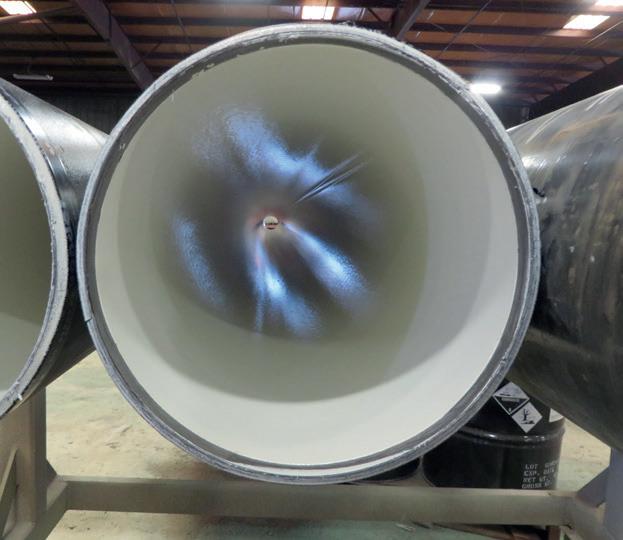



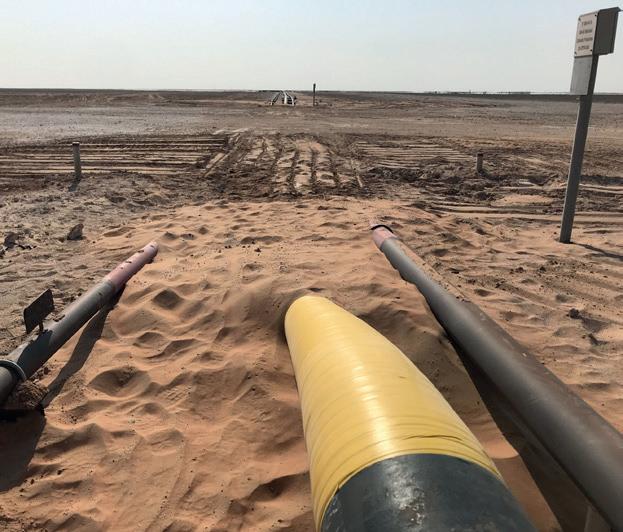
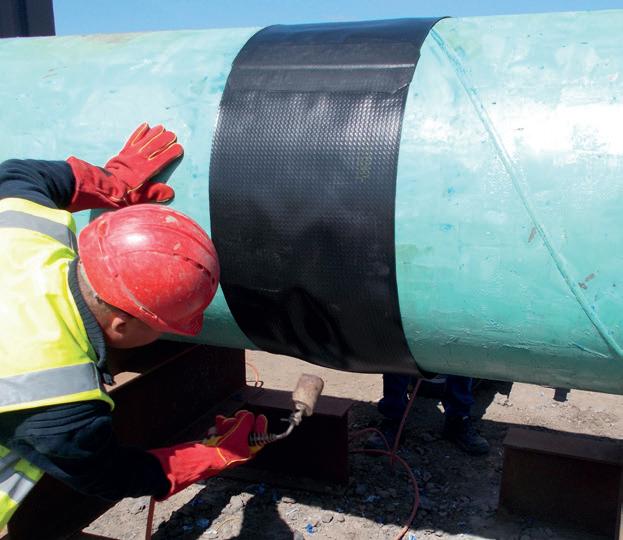
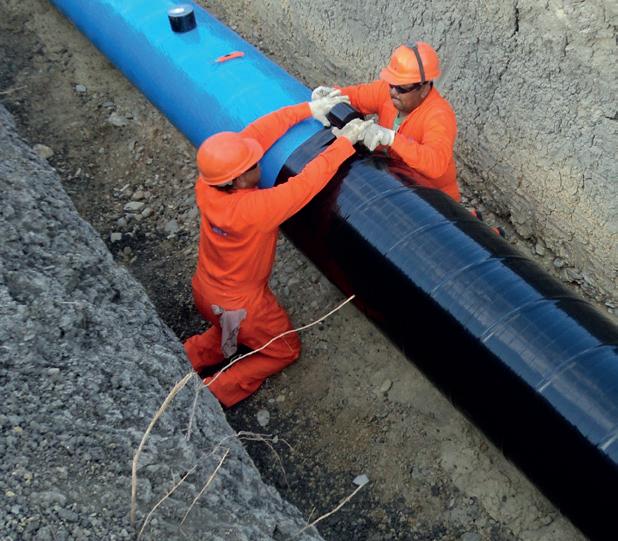

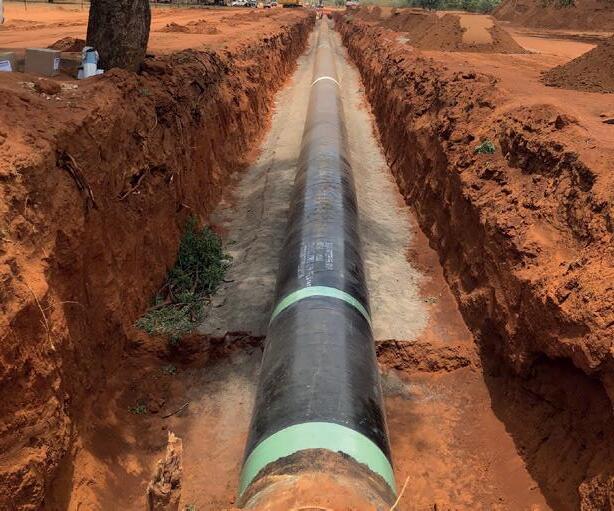
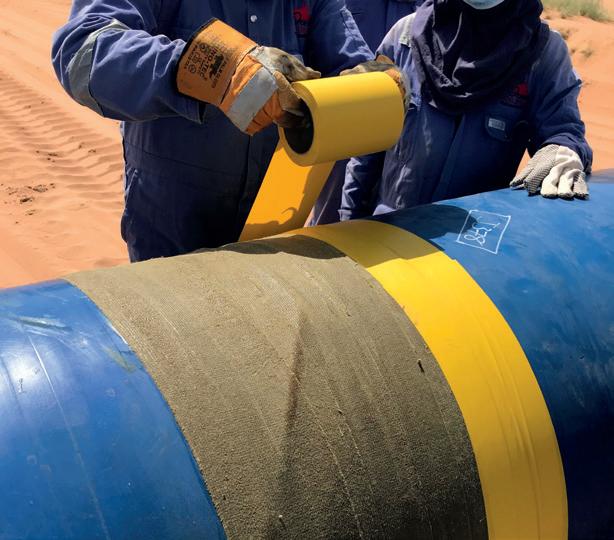
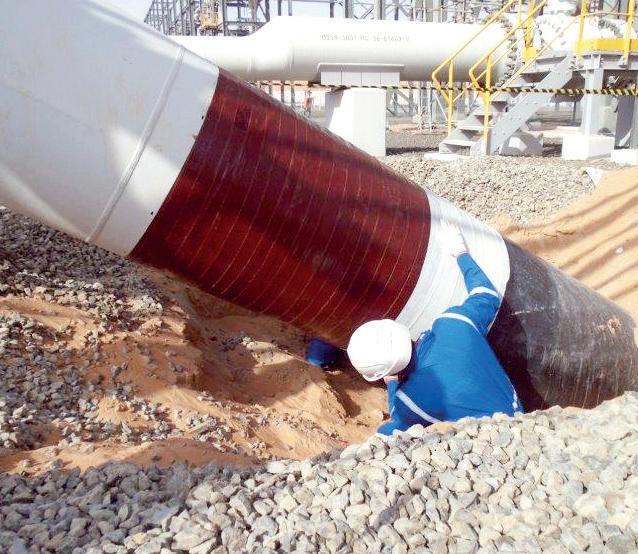

United Kingdom, UAE & India
USA & Canada
Australia & New Zealand
Republic of South Africa
FOR CORROSION PREVENTION
www.denso.net

www.densona.com
www.densoaustralia.com.au
www.denso.co.za
LIQUID EPOXY COATINGS PETROLATUM TAPE WRAP SYSTEMS BUTYL TAPE WRAP SYSTEMS PIPE LININGS BITUMEN TAPE WRAP SYSTEMSIllinois region. The seven-year-old station was relatively new, but at the time of construction, the original, economicallyminded systems integrator opted for proprietary architecture, and PLCs were already nearing the end of their life span.
For example, adding another step in an engine start up sequence required a control vendor to reprogram it at an additional cost for each improvement. Troubleshooting a problem or obstacle, particularly in the middle of the night or on the weekend, opens compressor operations to downtime risk.
CNP-MRT used the Horseshoe Lake station to create and prove a potential model to cost-efficiently develop, manage and implement a major control upgrade relying heavily on in-house resources. CNP-MRT selected a PlantPAx distributed control system from Rockwell Automation that integrates control and information, using an open architecture to combine the capabilities of a DCS system with pervasive access to engine operation data. Vastly improved asset visibility and production information give station operators the data to respond faster to maintenance, operation, and flow-control issues.
The upgrade enables station operators to manage speed and load control more easily, and the control system determines which compressor units should start based on engine hours and the number of engines the system controls. The visualisation capabilities within the PlantPAx system provide a window on compression by incorporating performance metrics and the situational display of production information at engine, station, and pipeline system levels. Accurate reporting of real-time engine events, analysis tools, and management dashboards deliver contextual, localised, rolebased information for better decision-making.
Automatic control system for oil and gas terminal
Supervisors of the EP Petroecuador Balao terminal decided to carry out a complete renewal and updating project of the pumping station operations, which included developing an automatic control system for managing the maritime terminal. At the Balao maritime terminal, they oversee the receiving of finished products and communication with the tankers that perform operations for loading and unloading derived products from hydrocarbons to and from the refinery in Esmeraldas.
The office of the supervisors of the Balao terminal serves an average of 450 ships/yr, both international and coastal. The supervisor of the Balao Terminal carried out a technical inspection of the terminal and decided to optimise its facilities, which included the total renovation of this station; the project led to the development of an automatic control system for managing the maritime terminal.
The terminal had pumping units that were 35 years or older that had received scant investment and maintenance during that time. The reliability of these units was very low, which generated a series of operational problems on an ongoing basis. Rockwell Automation’s automation and software division provided automatic control systems, process control networks, information Ethernet IP, and software for historicising variable management instruments and condition monitoring pumping units.
Other divisions of Rockwell Automation were also involved in the project. The power systems unit was responsible for providing the variable frequency medium voltage drives that were used to drive pumping units. The service unit was responsible for managing and overseeing all the sub-contractor work, and testing and commissioning MV drives. Finally, the systems and solutions unit completed the management and full integration of the project.
The implemented control system, the PlantPAx modern distributed control system, includes not only the monitoring of process variables or the management of control valves for appropriate products that will be pumped, but also integrates with the variations of frequency PowerFlex 7000 AC drives. This allows optimised control and management of the pumping system and the ability to control pressure with high precision, temperature, and flow of fuel, in addition to measuring the vibration and temperature in the bearings of pumps and key points to protect and increase the reliability of the pumping units.
With the implementation of this system, the port terminal managed to triple its capability of loading and unloading ships. This shows the solution provides a great benefit by reducing the downtime of a freighter, which means significant cost savings for the company. In addition, it was possible to optimise delivery to the Esmeraldas refinery for the processing and distribution of fuel.
The operation is also now very safe and reliable so that the pumps can be used at full capacity. With some control algorithms implemented by Rockwell Automation, they can determine the ideal time to slow down, thus reducing the pump flow. As a result, operations can also prioritise the quality of fuel transferred with the lowest possible risk. Before, all processes were performed manually, such as handling the different product lines and pumping units; now, they are conducted automatically, which allows, among other things, the reduction of hazardous mixtures of products.
Changing how the sector operates
Modern smart operations driven by the Industrial Internet of Things (IIoT) unite people, processes, and technology in an integrated network architecture. Modern systems help converge business-level IT systems with the station – and terminal-level operations technology (OT) systems to enable seamless connectivity across an entire oil and gas operation – from the pipeline to the oilfield and processing plant to the enterprise. Additionally, smart operations use the latest integrated control and information solutions to collect operational data and deliver it to workers as actionable intelligence.
Modern systems are changing the oil and gas industry as we know it. In particular, the IIoT enables the connection of smart devices and systems to offer the potential for pipeline operators seeking to optimise their operations and address their biggest challenges. Rockwell Automation and our PartnerNetwork members bring expertise in new pipeline construction and experience with existing system upgrades.
he oil and gas industry is embracing digital automation as a way to improve productivity, safety and sustainability across all their operational sectors –upstream, midstream and downstream. The global demand for petroleum and natural gas requires companies to venture further and deeper into new territories; at times, operating in remote and inclement areas under hazardous conditions to reach new reserves. To meet these challenges profitably, especially given the volatile dynamics of today’s energy markets, they are embracing Industry 4.0 advancements like automation, predictive analytics, digital twins and artificial intelligence/machine learning (AI/ML). As part of this, converged communications and field automation networks (FAN) are proving foundational to this transformation. The recent advent of industrial-grade private wireless networks such as 4G/LTE and 5G, as well as a proliferation of industrial IoT sensors and intelligent devices, is a game changer for remote operations across the resource extraction industry.
Wireless IoT and intelligent devices change the economics of digitalising operations. By generating more operational and environmental data, operators can become data-driven and introduce automation even in the most remote locations. Technologies like digital twins, AI and ML can leverage this data for powerful automation capabilities, as well as predictive analytics for everything from improved maintenance and safety to environmental protection.

Bridging legacy and future applications
Despite the promise of these new technologies, many of today’s oil and gas operations rely on legacy network technologies such as serial interfaces used in SCADA and other industrial systems for operational controls and in-plant communications. Operations can’t afford to add another overlay network to what is already a burdensome mix of old and new network technologies. With the explosion of new and intelligent applications, realtime data gathering is also now essential. AI and ML software
Jochen Apel, Head of Digital Industries, Nokia, explores how converged field automation networks support the digitalisation of oil and gas.
is only as good as the data it is trained on. Older purposebuilt networks serving specific use cases and applications are increasingly a barrier to realising this new data-driven paradigm. Even with new broadband wireless technologies such as Wi-Fi or LTE, the radio network sometimes still needs to be segmented so that every time a new application is deployed, in addition to configuring a new virtual local area network (VLAN) domain, a new Wi-Fi SSID or LTE Access Point Name (APN) is required. This paradigm incurs significant wireless network management overhead.
Internet protocol multi-protocol label switching (IP/MPLS) offers seamless convergence with its service aware QoS capability. By harnessing IP/MPLS multiservice capabilities, it needs only one APN at the LTE layer for the lifetime of the network. This allows oil and gas companies to build and configure the underlying LTE network only once and be ready for any legacy, new or future oil and gas applications. This seamless capability enables existing fixed networks used by operations centres to connect with remote field operations over LTE/5G.
Automation requires robust support of machine-to-machine communications. In addition, IP/MPLS VPN’s unique flexibility in multipoint Ethernet and IP services allows any-to-any direct communications over LTE/5G among all necessary automation subsystems anywhere – whether in the oilfield, along the pipeline or inside the plant – without needing to go through a central IP gateway. This capability makes it ideal for fast rollout of reliable communications to new use cases.
To support an automatic drilling system (ADS), for instance, it is necessary to connect different subsystems in real-time. This includes the top drive unit, the pipe handling equipment, and the sensors monitoring drill bit depth and penetration rate, as well as the automation controller to communicate. For this, IP/ MPLS can set up VPNs at both the IP and Ethernet layers (L3 and L2) – the latter being ideal for control applications using Profinet. It can assure strict quality of service across both the fixed and wireless networks, as well as very high reliability, which is critical to ensuring the performance of ADS.
For efficiency and seamless data exchanges, IP/MPLS provides oil and gas companies with a bridge between where they are and where they want to be – ensuring a successful digital transformation. It gracefully adapts legacy serial control data over IP, while accommodating all modern applications for control and monitoring. It also extends seamlessly over LTE or 5G wireless networks to mobile and stationary equipment and workers at the most remote locations.
An IP/MPLS converged FAN creates a seamless end-toend converged communications layer that can accommodate everything from supervisory control and data acquisition (SCADA) and push-to-talk services to 8K video, drones and industrial IoT. It empowers oil and gas companies to overcome their challenges in areas like search and prospection, drilling and extraction, situational awareness and predictive maintenance.
Search and prospection
Typically, exploration teams are forced to communicate with each other and back to the office using expensive and bandwidthlimited satellite phones. This is because the process of search and prospection is often an isolated exercise that feels nomadic, and places teams as well as their equipment in remote areas – usually without access to a communication network. As a result, the engineers in the field also have to collect, transport and deliver their data manually using laptops, hard drive disks and USBs. This means, however, that they don’t have access to some of the most powerful analytics tools to help predict the location of high potential oil and gas fields. These models are too complex to be run on a laptop and require access to cloud compute resources.
For these kinds of remote operations, a portable LTE configuration can be set up in minutes and serve hundreds of users, even in the most extreme conditions far from existing coverage. Paired with a satellite or microwave link, this solution can provide high bandwidth mobile connectivity for sensors, field workers and drones; both for collecting data, as well as providing field workers with access to remote data and remote processing capacity. Once the connection is established, the IP/MPLS





network can seamlessly connect the local team with operations and data centres feeding data from the field – processing it in the data centre and giving them near real-time analytics.
Drilling and extraction
Although mostly manually operated today, companies are pursuing a strategy of extreme autonomy for drilling and extraction. It will not only improve safety with crewless rig floors, but promises greater efficiency and performance on the rig and in the wellbore itself. Similarly, supporting automation with remote operations allows personnel to operate machinery from a distance via virtual telepresence so they can monitor the automated processes as a supplement.
As the resource extraction industry struggles in some geographies to hire qualified workers in far-flung locations for hazardous jobs, leveraging rig automation promises to offer safer jobs and more consistent performance – even with inexperienced crews who only need to focus on supporting the automated driller with maintenance, inspection and rig moves. Cloud-based ML can also be used to optimise drilling performance using, for instance, automated reaming, MSE-based ROP optimisation and automated downlinking to the rotary steerable system. Having the ability to operate equipment remotely from an offsite operations centre makes no difference to the rig operation but makes the work more attractive and enables remote expert personnel to oversee more than one rig at a time.
Additionally, robots and drones can replace the manual inspection of facilities including offshore sites, inside tanks and pipes, platform parts and complex or hazardous access points. Thousands of manual operations and processes can be transformed into a small number of automated processes, controlled remotely if the communication platform can meet the bandwidth and latency requirements.
Remote operations, however, require high bandwidth and low latency connectivity. Remote drilling platforms typically have ten or more cameras streaming high-definition video. At the same time, remote controls must be near instantaneous, requiring low latency communication links. This is where the network becomes pivotal: LTE and 5G wireless networks can provide the kind of bandwidth required to meet the latency requirements for remote control of machinery locally, using a satellite or microwave link to connect the rig with the remote operations centre.
Situational awareness and digital twins
The safety, sustainability and security of future oil and gas operations rely heavily on situational awareness. Video coverage and massive sensing can help with this, but in order to achieve 360˚ awareness, the wireless network must be able to meet the excessive bandwidth demands of video cameras across an entire coverage area spanning onshore and offshore assets in order to properly support remote drilling operations. Many of these cameras may be mounted on mobile vehicles or drones, which can also be equipped with infrared, environmental sensors and loudspeakers for warning workers and intruders away from red zones or directing personnel during extreme events.
The network must be able to manage and connect thousands of IoT sensors that enable machine health and
diagnostics, position reporting, process monitoring and control, as well as environmental monitoring. In addition, the network must also be able to support smart tools, communication devices and digital PPE for mobile workers. This data can be fed into digital twin software for a digital model of the physical environment, constructed using geological, engineering and asset information. It can be continuously updated with data from sensors, cameras, drones and location-aware mobile devices. By using virtual simulations of the work environment, operators will be able to create long-term and short-term schedules, make accurate estimates for personnel and machine efforts, and predict what the end product results will be.
Drones can also survey, map and take volumetric measurements of a site to construct a 3D digital image of it used for monitoring, inspecting and mapping wellheads, pipelines and storage tanks. Augmented and virtual reality (AR/VR) systems will use the digital twin to provide offsite and onsite staff with real-time information and scenario simulations, while AR glasses provide step-by-step instructions to service engineers.
Predictive maintenance using IoT and analytics
Maintenance and repair of vehicles and equipment poses challenges in planning the availability of replacement parts as well as scheduling maintenance teams and resources. Breakdowns and unscheduled maintenance of ageing assets can wreak havoc with operations, with rig downtime being measured in millions of dollars per day.
Predictive maintenance applications use data collected from IoT sensors to feed asset management and advanced data analytics. By recognising anomalies in the data, these applications can alert personnel to the need for inspection. Relying on calendar-based maintenance schedules from the vendor isn’t enough either, because doing that alone results in many assets failing during operations. On the other hand, conducting maintenance too often can also lead to waste by replacing or refurbishing assets that could still be viable as is. Because they generate more accurate profiles for each piece of equipment, predictive maintenance software can avoid the shortened inspection windows suggested by the manufacturers’ calendar-based schedules, secure in the knowledge that the monitoring applications will alert them to potential issues should they arise earlier than expected.
FANs key to digital transformation
As oil and gas companies face an array of constantly changing business conditions and more stringent environmental regulations, there is a pressing need to digitally transform their operations. Technologies like industrial IoT, digital twins, predictive maintenance, automation and remote control will lead the oil and gas 4.0 transformation.
Connecting remote prospection, drilling, wellheads and pipelines to data centres and operations, a robust and reliable FAN based on the convergence of IP/MPLS and industrialgrade wireless will be essential. This seamless connectivity platform will ensure that oil and gas operations can take maximum advantage of their end-to-end data to modernise their operations, improve safety and ensure profitable and sustainable operations.
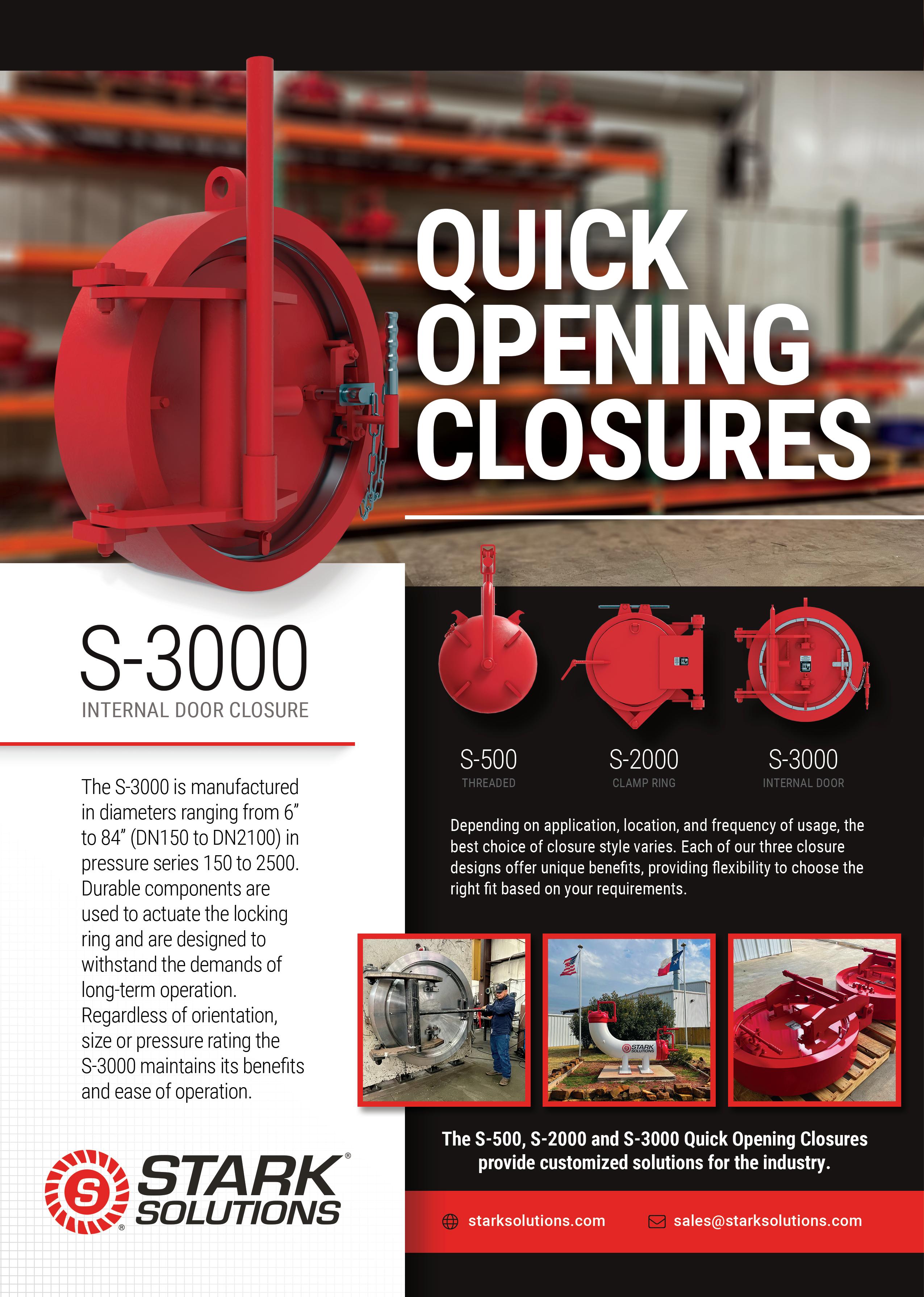
Using advanced analytics solutions, pipeline operators can automate data aggregation and cleansing, speed up process insights, and increase shareability among teams, says Morgan Bowling, Industry Principal, Seeq Corporation, USA.

n the world of digital technology for process control, various systems have been used to monitor, collect, and process data in real-time for decades. These include supervisory control and data acquisition (SCADA) systems, historians, laboratory information management systems, and databases.
The seemingly endless supply of time series data can be referenced to identify situations where optimisations can improve operational efficiency and reduce upsets, providing opportunities to drive progress toward critical corporate initiatives. Yet, many organisations face challenges accessing and connecting data from these systems – which are often siloed – analysing it efficiently, and operationalising insights in an effective manner.
Addressing these and other issues, modern advanced analytics solutions are enabling pipeline operators and organisations throughout the process industries to automate data aggregation and cleansing. This helps companies decrease time to value, shift operations and maintenance from reactive to proactive and predictive, and more easily share insights with multidisciplinary teams. It also empowers teams to spend more time digging into and analysing data to identify operational issues and areas for improvement, aiding in decision-making and ultimately driving business outcomes.
Data wrangling challenges
While analytics applications have come a long way over the past decade, a staggering number of process engineers and data analysts are still stuck using spreadsheets for data aggregation and analysis, requiring inordinate hours manually prepping and cleansing information from

multiple sources. Spreadsheets are wrought with limitations, including subpar computational capability, lack of live data connectivity, prohibitively difficult shareability, and clumsy visualisation and reporting functionalities.
Void of live connections to both historical and live data sources, these subject matter experts (SMEs) are forced to manually query each individual database, extract the necessary data for analysis, then aggregate and align mismatched timestamps in a spreadsheet. When a new time period of interest is identified, the process must be repeated.
With so many hoops to jump through, it is easy to understand why nearly 80% of engineers, scientists, and analysts surveyed in a 2016 CrowdFlower study reported spending more time collecting and wrangling data into formats suitable for analysis than any other task (Figure 1).1
Using spreadsheets to analyse process data is filled with obstacles, and leaves little time for gleaning meaningful insights, preventing organisations from making sense of data in the broader business context to glean insights necessary for increasing operational efficiency and profitability.

Automated data conditioning and reporting saves valuable time
By leveraging advanced analytics solutions, organisations can move away from spreadsheets – automating data collection, conditioning, and subsequent reporting – and free up large periods of SMEs’ time, empowering them to reallocate it to optimising operations and improving plant efficiency.
Many of the world’s largest oil and gas companies are deploying advanced analytics solutions, like Seeq, to provide these automated and self-service analytics capabilities to their SMEs. By installing these types of solutions, teams can immediately alleviate the challenges of live data connectivity because the software automatically connects to and aggregates data from many types of disparate sources into a single platform. All the while, information integrity is kept intact because the analytics application does not modify any source data in their original repositories. Automated data cleansing and contextualisation significantly reduces the time spent preparing data for analysis, leading to quicker insights.
Without data access and preparation barriers to worry about, SMEs can leverage purpose-built, point-and-click tools for descriptive, diagnostic, predictive, and prescriptive analytics to improve performance based on reliable insights. Advanced analytics solutions incorporate visualisation into the analysis workflow, empowering SMEs to see the impact of their analyses in near-realtime, pinpoint missteps, identify and share successes, and iterate and innovate more quickly than before.
These innovative solutions empower SMEs to identify unique periods of interest in their data, characterised by qualities known as conditions, to determine when equipment is exhibiting abnormal operational behaviour. These conditions can be established by superimposing multiple operational parameters, then defining time periods of interest by finding rapid process value changes, specific signals, or trends that exceed static operating limits (Figure 2).
In the point-and-click environment, SMEs can easily configure the process in machine learning capable models without assistance from IT resources, almost regardless of their coding-literacy level. Once unique conditions are defined for a single asset, advanced analytics solutions empower teams to seamlessly scale a single configuration across a fleet of similar equipment for near-real-time monitoring.
Automating greenhouse gas reporting
When Chevron sought to automate their regulatory compliance reporting for
 Figure 1. A CrowdFlower survey revealed data scientists and other operations personnel spend an inordinate amount of time preparing data for analysis.
Figure 1. A CrowdFlower survey revealed data scientists and other operations personnel spend an inordinate amount of time preparing data for analysis.
a Qapqa brand
• Increase productivity
• Increase quality
• Lower repair rates
• High level of support
Together, we create the most distinctive and integrated welding solutions for the construction of reliable and sustainable pipelines.

Whether it’s oil, gas, or any other fluid, we are here to ensure reliability and make projects run smoothly. Quality is top priority, we settle for nothing less than perfection.

No matter location, challenges, or circumstances, Qapqa is your go-to partner for exceptional welding solutions. From remote deserts to high altitude environments, we deliver our expertise to every corner of the globe.

Qapqa. Joining solutions.
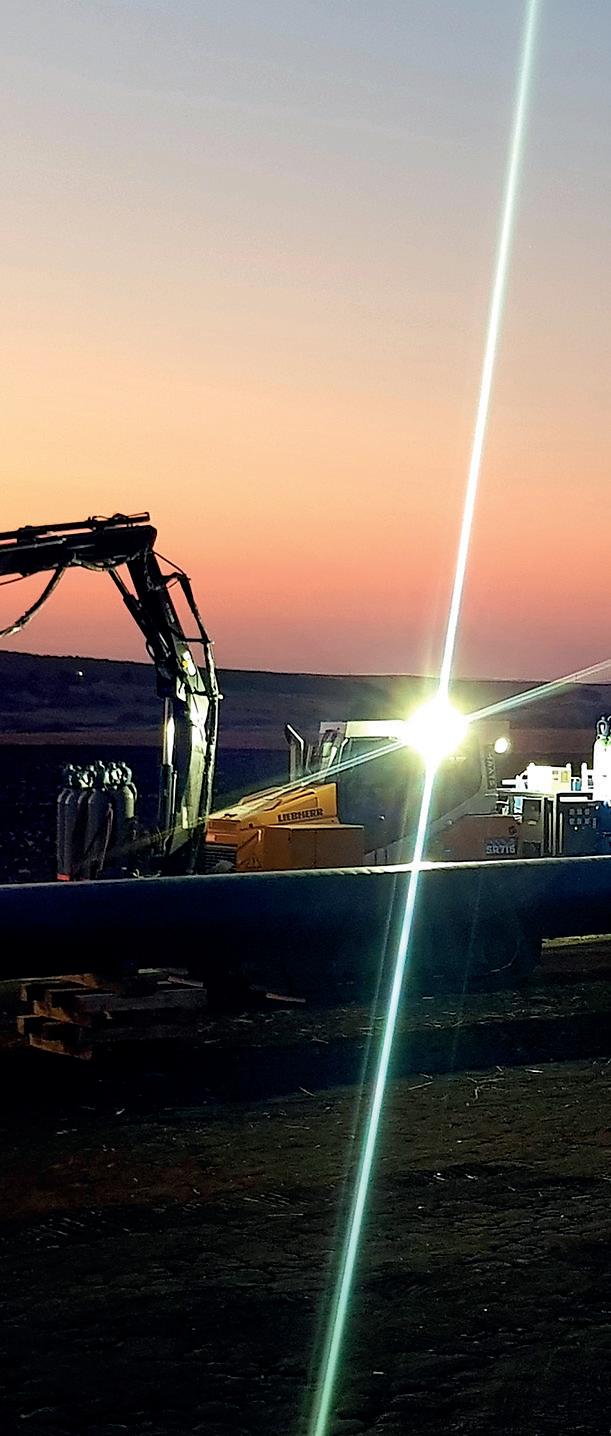
greenhouse gas (GHG) emissions across their refineries, they turned to advanced analytics to automate this workflow. By leveraging Seeq, the company introduced the ability to access data from refinery historians and apply calculations and contextualisation for quarterly regulatory emissions reporting.

Additionally, extensibility features within the solution empowered the team’s SMEs to create a custom solution for extracting final emissions data and formatting it for direct ingestion into their corporate GHG reporting software (Figure 3). With automatic calculations and real-time updates that incorporate the latest data, Chevron reduced analysis time from two or three days to only a few hours. Most notably, the up-to-date and readily available emissions performance information enabled the company to take a proactive approach to emissions identification and mitigation, resulting in prevention in some instances, rather than reporting events long after the fact.
Automating exception-based surveillance
Marathon Oil, where teams are tasked with monitoring nearly 4000 wells, recently eased this substantial task by implementing and scaling Seeq across the enterprise. The company achieved this by automating workflows to create alert types, reducing the time required for this task from months to hours. These intelligent alerts are used to drive and prioritise maintenance tasks and work orders for personnel in the field, and they empower operational teams to reduce unplanned outages, ultimately increasing production and profitability.
The company improved scalability by using Seeq to connect production data from across all its wells. The company has over 50 employees using the solution with 170 Seeq Workbench analyses. It generates 1500 tasks, and
over 1500 notifications a month. What was being manually identified in the past is now automatically generated, increasing production capacity by proactively identifying issues to increase uptime.2
Marathon Oil achieved this scale by placing curated technology in the hands of its personnel, empowering them with notifications and insights to operate efficiently.
Embracing advanced analytics applications for digital maturation
For pipeline operators, leveraging advanced analytics solutions like Seeq is critical in today’s information landscape to provide staff with the tools they need to contextualise, analyse, and make the right decisions. Powerful technology by itself does not ensure success, but software tools with wide-reaching connectivity, automated data cleansing, cloud access, capable algorithms, and intuitive collaboration means cannot be overlooked.
Advanced analytics solutions designed to scale highvalue use cases across assets can increase the rate of digital maturation in an organisation, but even these software solutions require strong foundations of data storage and accessibility. Digital transformation is an organisation-wide initiative, and placing analytics tools in the hands of all personnel can significantly increase adoption. By empowering employees with these capabilities, companies can count on advances in profitability, sustainability, and safety as process optimisation and insight sharing spreads.
References
1. CrowdFlower Data Science Report 2016 (https://visit.figure-eight.com/rs/416ZBE-142/images/CrowdFlower_DataScienceReport_2016.pdf )
2. https://aws.amazon.com/partners/success/marathon-oil-seeq/
The non-destructive test (NDT) service market for pipelines is at a crossroads, with an inevitable need for transformation looming on the horizon. On the one hand, the market is poised for unprecedented growth. According to Fortune Business Insights, the global NDT market size is expected to reach US$16.66 billion by 2029, with a CAGR of 13.66% during the forecast period. Demand has been galvanised by governments around the world, tightening safety and environmental regulations.

In addition, an unprecedentedly high level of ageing infrastructure will require massive
investments and monitoring to maintain operational capacities. For example, the American Society of Civil Engineers (ASCE) Report Card for America’s Infrastructure gave a blistering Cfor the US’ infrastructure. While the score was bumped up from the D to D+ range for over 20 years, it still shows general signs of massive deterioration, which increase the likelihood of functional and performance deficiencies, and increase vulnerability to risk.
ASCE estimates that investments of US$281 billion/yr are needed to reverse the impact of infrastructure failure. If investments are not made, the report indicates it will cost America US$10 trillion in GDP by 2039. The need for NDT services is definitely set to skyrocket.
However, challenges are rampant despite robust demand for NDT services, whether in-house or by third-party businesses. The main hurdle? Workplace demographics. Based on statistics by Zippia, a major career site, the average age of NDT technicians, which comprise 66% of the
workforce, is 45 years. As many NDT managers know, these professionals are prone to retire early. What’s more, only 12% of NDT technicians are under the age of 30. With unemployment rates in the profession hovering at 2 - 3%, the ripple effects of a crippling labour shortage become blatantly clear.
Indeed, a perfect storm is brewing for the NDT industry, compromising demand fulfilment.
Modern challenges require modern technology
To successfully weather this storm, NDT companies and teams must adopt a proactive approach to their service
management. This includes investing in training and development programmes to attract and retain skilled workers, and implementing new technologies to improve NDT efficiency and boost service capacity.
The World Corrosion Organisation claims that infrastructure by corrosion damage alone is estimated to cost US$2.2 trillion worldwide each year. The organisation says that between 20% and 25% of corrosion costs could be mitigated by using new technologies and innovative maintenance programmes. In order words, investing in new technologies and developing a proactive maintenance programme could not only help reduce the impact of the aforementioned challenges but also generate a high return on investment (ROI). One such technology investment is through better instrumentation, such as 3D scanning, to elevate and accelerate decision-making.
In the past, NDT businesses were often hesitant to adopt new technologies and make investments to implement new inspection methodologies. But with the new demand and technician shortage imperatives, 3D scanners can unlock impressive operational opportunities that counter-balance the investment.

Scanner benefits
For one, metrology-grade 3D scanners, like Creaform’s HandySCAN 3D or Go!SCAN 3D, are user-independent. That means that the 3D scanner can generate repeatable
 Figure 1. Surface analysis of pittings cluster on a cylindrical transportation pipeline.
Figure 1. Surface analysis of pittings cluster on a cylindrical transportation pipeline.



and accurate results of up to 0.0009 in., regardless of the operator’s skill level or experience. 3D scanning is the most accurate technique to measure surface damage, which gives asset owners peace of mind knowing they are making decisions based on unequalled inspection accuracy.
3D scanning is also a simple technique. It requires no lengthy training or extensive certification process. Offering short learning curves and quick set up times, 3D scanners can easily be deployed inside any organisation. Besides their simplicity, 3D scanners’ portability enables inspection teams to transport them to any site and reach constrained areas that were either too cumbersome or dangerous to attain with conventional methods.
Some 80 times faster than the traditional pit gauge method, 3D scanners drastically improve the productivity of NDT teams and avoid unnecessary infrastructure downtimes, staving off costs and ensuring asset owners preserve their service line agreements.
The future of 3D scanning NDT software
To help inspection teams address market and labour challenges, Creaform has developed a 3D scanning software platform, VXintegrity, based on Pipecheck software and designed specifically for surface damage assessments conducted by NDT teams that cater to the pipeline industry (Figure 1).

Creaform 3D scanners bundled with VXintegrity offer metrology-grade accuracy, traceable data over time and human-independent results that eliminate measurement variations and ambiguity in the interpretation of inspection data.
VXintegrity features several software modules that enable inspection teams to dive deeper into their assessments. The Pipeline Inspection module, formerly known as Creaform’s Pipecheck software, has become the industry reference for assessing mechanical damage on pipelines. Over the years, by integrating automatic defect pattern recognition, interaction parameter and ASME B31.G pass or fail criteria, Pipecheck has greatly reduced the latency time between digging a pipe and re-burying it because inspectors can generate reports onsite. This massive increase in productivity has generated millions of savings for the pipeline owner.
The surface damage module provides users with tools to analyse absolute measurements of thickness loss, dents,
 Figure 3. Damage monitoring represented on different industrial components being subject to in service damage and wear.
Figure 3. Damage monitoring represented on different industrial components being subject to in service damage and wear.
gouges, and corrosion on pipeline and pipeline components of any type of geometry (Figure 2). VXintegrity now offers new software capabilities to analyse mechanical damage, such as dent and corrosion, on any type of surface. In fact, accurately measuring damage on complex geometries –without any errors – is a game changer. Curve geometries and others, such as elbows, valves, T-joints, nozzles, and reducers, can now be easily assessed with the same confidence level as the rest of the pipeline.
Ireland-based IPEC Inspection Ltd carried out a major commissioning project by replacing pit gauges and UT sets with a Creaform Go!SCAN Spark 3D scanner and integrated Pipecheck software – and saved over two days of inspection work.
While pent-up NDT demand and lack of skill labour show no signs of abating any time soon, NDT service companies can access innovative technologies to ease the pressure. Solutions like 3D scanners with integrated inspection software contribute to keeping up the pace with projects and honouring contracts with a smaller workforce.
High voltage Holiday Detector
Detects holidays, pinholes, and other discontinuities using continuous DC
t i r
o l t
r a n g e f r o m 0 5 t o 3 0 k
n
Finally, with the introduction of the damage monitoring module, Creaform developed tools that allow access to all the information required to perform repairs (Figure 3). This new module could be compared to a basic metrology tool kit that allows them to digitally measure difficult geometries, including ovality deformation, radius bending of a pipe section, wear on a flange surface, and more (Figure 4). Moreover, this module includes all the features needed to quickly compare a digital asset to a CAD model, a perfect geometry, or even a previously digitalised damaged surface. Inspectors can then determine corrosion rates and pre-emptively identify the right repair dates. This module definitely maximises the information and documentation value for predictive and preventative maintenance.
p t o 1 6 h o u r s o f b a t t e r y l i f e p o w
r f
t
r i
s f i t n e a t l y w i t h i n t h e
o m p a c t w a n d h a n d l e e l i m i n a t i n g t h e n e e d f o r a s e p a r a t e b a t t e r y b o x n B u i l t - i n C e r t i f i e d Vo l t m e t e r a n d Vo l t a g e C a l c u l a t o r f e a t u r e n I n d u s t r y s t a n d a r d c o n n e c t o r s a n d a d a p t o r s p r o v i d e c o m p a t i b i l i t y w i t h n e a r l y a l l e x i s t i n g e l e c t r o d e s
VXintegrity gives the tools
NDT companies need to generate reports for asset owners as well as archive the wealth of 3D measurement data in the event audits are carried out or to prove regulatory compliance.
Proven in the field
Many ahead-of-the-curve NDT service companies are already leveraging the potential of 3D scanning and inspection software.


Hydro Safety Engineering, based in Europe, assessed the degree of wear of an almost 100 year old pressure pipeline with a deep entry into the penstock full of water and mud.
Tilt Inspection & Consulting, a major NDT business in Western Canada, elevated the quality of the reports they sent to clients and cut onsite inspection times, which contributed to impressive cost-savings.
No shoulder bag required!
Also available with Pulsed DC
High voltage Holiday Detector
Stick-type with Pulsed DC
Wand-style with Continuous DC

or the last several years, North America’s energy industry has been experiencing unprecedented upheaval. Gyrations in demand due to COVID-19, deadlines for net-zero carbon emissions, environmental activism and the side-effects of the Ukraine war have all created tremendous economic and logistical complications that affect every aspect of the sector, including pipelines.
Canada

Canada is blessed with an abundance of hydrocarbons; both conventional and unconventional. While most attention has been focused on production of gas from shales in the US, the Montney formation in northeast British Columbia (B.C.) has been flying under the radar. The extensive shale contains an estimated 450 trillion ft3 of gas and currently produces 5.8 billion ft3/d. Producers have proposed processing capacity to eventually double production to 11.5 billion ft3/d. Several pipeline systems are being expanded to meet the expected increase. Enbridge has earmarked CAN$1.9 billion to expand its Westcoast natural gas system that services B.C. and Alberta. In November 2022, it announced an open season to its T-North segment, which runs from Fort Nelson in northern B.C. to southern and eastern consumers. Sufficient consumer interest could result in an additional 500 million ft3/d of capacity.
Construction on TC Energy’s Coastal GasLink pipeline is nearing completion. The 670 km line runs from northeastern B.C. to the Pacific port of Kitimat, where it will supply up to 2.1 billion ft3/d of gas to Shell’s LNG Canada plant (currently under construction). The pipeline, which is scheduled to come online in 2023, has been plagued by fractious protests from First Nations factions opposed to the ROW crossing ancestral
lands. Cost overruns due to labour shortages and logistics related to COVID-19 have also caused the budget to grow from an original CAN$6.6 billion to over CAN$14.5 billion. Despite the challenges, TC Energy is in discussions with Shell in regards to Phase 2 of the latter’s LNG project that would require increasing capacity to 5 billion ft3/d.
In late 2022, Enbridge launched a successful open season on an expansion programme on the T-South portion of its pipeline system in B.C. The system runs from the Ft. St. John region in northeast B.C. to the US border south of Vancouver. The Sunrise Expansion Program would increase export capacity by 300 million ft3/d through looping and additional compression. Pending FID, the expansion is being targeted for 2028.
Canada’s total crude production exceeds 5 million bpd. The oilsands of Alberta is the largest single source, with 3.3 million bpd, and output is expected to rise to 3.6 million bpd over the next decade. Canada exports approximately 4 million bpd to the US, which is expected to rise to 4.2 - 4.4 million bpd by 2026.
Because its export markets are limited, Canadian crude is often sold at significant discount when US refineries go offline or demand slows. In order to develop alternative outlets, Kinder Morgan initiated an expansion of the Trans Mountain line (TMX), which carries 300 000 bpd from Alberta to the port of Burnaby, B.C., near Vancouver. The TMX has also confronted significant environmental opposition, as well as COVID-19 related delays and severe flooding of the ROW. As a result, the cost has increased from an original estimate of CAN$12.6 billion, to over CAN$21 billion. Once the expansion becomes operational in 2024, it will deliver up to 890 000 bpd to its expanded Burnaby terminal. Ironically, the primary expected destination is no longer Asia; refiners in that region are gorging on cheap Russian oil, and the likely buyers for TMX output will be in Washington State, Oregon and California.
USA
In the US, pipeline growth is being driven primarily by the push to export gas and crude from the US Gulf Coast (USGC) to jurisdictions around the world. According to the Energy Information Administration (EIA), USGC (PADD 3) exports averaged 2.48 million bpd in 2021; by late 2022, that number had grown to over 4 million bpd, with the majority of the increase coming from the Permian basin and Western Canada.
Increasingly, midstream efforts are focusing on export facilities. In May, 2023, Enbridge announced a binding open season for the Flanagan South pipeline expansion. The 720 000 bpd pipeline runs from Illinois to Cushing, OK, and the expansion would add another 110 000 bpd capacity for Western Canada and Bakken crude. Flanagan South pipeline connects to the Houston region via Enbridge’s 950 000 bpd Seaway Pipeline. Enbridge recently announced that it was proceeding with the Enbridge Houston Oil Terminal (EHOT) at the southern end of its Seaway Pipeline. The first phase of the new facility will have up to 2.5 million bbls of crude storage, with the potential to expand to 15 million bbls.
Enbridge is also beefing up its export facilities in Corpus Christi, Texas. In 2022, the company assumed operatorship of the Gray Oak pipeline, which delivers 900 000 bpd from the
Permian Basin to Enbridge’s Ingleside Energy Center (EIEC) in Corpus Christi. Enbridge and Plains also purchased the majority interest in the Cactus II pipeline, which delivers 670 000 bpd from West Texas to EIEC. EIEC is the largest crude oil storage and export terminal by volume in the US, with approximately 15.3 million bbls storage capacity. Enbridge is adding almost 2 million bbls of new storage in the next year.
After suffering decreases during COVID-19, US gas production is once again climbing; the EIA expects dry gas production to exceed 100 billion ft3/d in 2023. Much of that has been within the Permian basin. Associated gas in the Permian has risen from pre-pandemic level of 17.4 billion ft3/d in 2019 to the current level of 22.5 billion ft3/d.
US demand has been slowly decreasing, and now stands at 87 billion ft3/d. Part of the 13 billion ft3/d gap is slated for export to Mexico. Kinder Morgan’s new 2.1 billion ft3/d Permian Highway Pipeline (PHP), is a 430 mile pipeline from West Texas to the Gulf Coast, where it has additional connections to Mexico’s interstate pipeline network.
Gas is also being exported via LNG. The EIA estimates that LNG exports will average 12 billion f3/d in 2023, up from 10.65 billion ft3/d in 2022. An estimated 100 million tpy of new projects, representing over 14 billion ft3/d, are on the planning boards. Several expansions and new pipelines are planned to enter service in the next several years. WhiteWater and partners expect the Matterhorn Express to enter service in late 2024. The 490 mile long line will deliver up to 2.5 billion ft3/d from the Waha Hub in West Texas to Katy, Texas, near Houston. The company is also expanding its Whistler Pipeline by 500 million ft3/d, to 2.5 billion ft3/d. In June, 2022, Williams reached an FID to build the Louisiana Energy Gateway, a 1.8 billion ft3/d greenfield project designed to deliver gas from the Haynesville basin to LNG projects on the Gulf Coast. The US$1.5 billion pipeline is expected to enter service in late 2024.
NGLs
US production of natural gas liquids (NGLs), which includes ethane, propane and butane, has grown from 1.8 million bpd in 2008 to 6 million bpd in 2023. The growth has been largely driven by shale production, as well as greater gas-to-oil ratios. Gathering and processing facilities have grown in tandem, resulting in thousands of miles of dedicated NGL pipelines. Targa Resources is a major NGL player. It owns and operates over 14 000 miles of lines in the Permian Basin region, as well as 33 processing plants with a total capacity of 7 billion ft3/d. It operates the 550 000 bpd Grand Prix line that ships product to the Mt Belvieu NGL hub in Texas. Targa operates the Galena Park Marine Terminal adjacent to Mt. Belvieu. The facility, with a loading capacity of 450 000 bpd, can handle very large gas carriers. In late 2022, Targa announced it was building the 400 000 bpd Daytona line, to be completed by 2024, raising system capacity to almost 1 million bpd.
Legal and regulatory problems
Environmental activists intent on eliminating oil and gas usage find pipelines a tempting legal target, as do populist politicians. Enbridge’s Line 5 transports 540 000 bpd from Canada (and North Dakota) through Michigan to Ontario and
INNOVATIVE AND CUSTOMIZED SOLUTIONS FOR EVERY CHALLENGE since 1958


WIDTH 2550 MM: STANDARD EUROPEAN TRANSPORTATION LIMITS, WITH COMPLETE ASSEMBLED MACHINE
HYDROSTATIC, VARIABLE SPEED ESCALATOR
TWO-SIDE BELT WITH HYDRAULICALLY-CONTROLLED EXTENSION





Quebec. In late 2020, Michigan Governor Gretchen Witmer ordered Line 5 to shut down operations, due to the potential for spills where it passes under the Straits of Mackinac in the Great Lakes.
Enbridge submitted an application to build a CAN$750 million tunnel in 2020 to address these concerns. But the US Army Corps of Engineers (which is responsible for the federal permitting process), pushed back the original plan to publish its draft environmental impact statement from late 2023, to spring 2025, meaning that construction of the 6.4 km tunnel is unlikely to commence until 2026.
As an international pipeline, Line 5 is governed by the 1977 Transit Pipelines Treaty, which contains provisions guaranteeing uninterrupted transit of light crude oil and natural gas liquids between Canada and the US. In order to maintain service, Ottawa invoked Article Six of the treaty in late 2021 to instigate bilateral negotiations with the US federal government.
Line 5 faces further opposition from the Bad River Reservation, located on the ROW in the southwestern shores of Lake Superior. Band members sought a summary judgement against Enbridge that would have shut the line down without a trial. In November, 2022, a Wisconsin judge denied the request to shut the line down and ordered the two sides to seek solutions that would mitigate the risks of a spill while continuing operations. In June 2023, however, the US District Court in Wisconsin ordered the company to stop operating the oil pipeline within three years and pay the band US$5.15 million. Enbridge, which has stated publicly that it is endeavouring to find a solution to the band’s concerns by re-routing the ROW, plans to appeal a court order.
The Mountain Valley Project (MVP), a gas pipeline designed to move 2 billion ft3/d from West Virginia to consumers in Virginia and the south Atlantic seaboard, continues to face environmental opposition. First proposed in 2018, the line was estimated to cost US$3.5 billion, but a 5 km stretch of the 488 km ROW passes through Jefferson National Forest and, in early 2021, the US Court of Appeals (4th Circuit) vacated the US Forest Service and Bureau of Land Management decisions to allow access. In August, 2022, Joe Manchin, a Democrat senator from West Virginia, got the White House’s agreement to tack on an amendment to a multi-billion tax and climate bill that would streamline the completion of the pipeline. In July 2023, a panel of judges on the US Court of Appeals (4th Circuit) ordered construction to halt while it reviews the Biden administration’s approval; the project remains in limbo as costs balloon past the US$6 billion mark.
Green alternatives
In 2021, the government of Canada enacted the Canadian Net-Zero Emissions Accountability Act that provides a legally-binding roadmap to achieve net-zero greenhouse gas emissions by 2050. The Act also specifies that emissions are to be reduced up to 45% of 2005 levels by 2030. That same year, the Biden administration announced a target to reduce US GHG emissions by 50% of 2005 levels by 2030.
State and federal subsidies are incentivising CO2 pipeline projects in the US. Summit Carbon Solutions is proposing a
CO2 pipeline network to capture the gas produced in Iowa ethanol plants and sequester it in North Dakota. The 2000 mile network is estimated to cost US$2 billion; it would capture up to 12 million tpy, significantly reducing the carbon footprint of the biofuel.
Renewable fuels developer HIF Global has plans for a US$6 billion green hydrogen fuel plants in the Bay City area of Texas. When completed in 2026, the plant will produce 200 million gal./y of green fuels. Air Products and partners are building a US$4 billion plant in Wilbarger County, Texas, to produce 200 tpd of green hydrogen. While output from the new hydrogen facilities will primarily flow through the dedicated lines currently servicing refineries, petrochemical and fertilizer plants, opportunities for pipeline expansion will arise as new facilities seek low-carbon feedstock and energy inputs.
In July, 2023, Exxon Mobil purchased Denbury Inc. for US$4.9 billion. The latter’s primary asset is over 2000 km of CO2 pipelines. Exxon Mobil has set a net-zero emissions deadline of 2050, and the purchase will allow it to capture and sequester CO2 from its operations.
Complications
The Biden Administration has set a goal of net-zero emissions in the electricity grid by 2035. According to the EIA, about 60% of all US electricity generation is from fossil fuels, primarily coal, natural gas and petroleum. Approximately 18% is from nuclear energy, and about 22% from renewable energy sources including wind, solar and hydropower.
While wind and solar are set to increase significantly, increased usage from EVs and other electrification initiatives will place greater strain on the electrical sector, especially over the issue of intermittency associated with wind and solar. Alan Armstrong is President and CEO of Williams, a major pipeline company. “We are seeing and feeling today the impacts of inadequate infrastructure with consumers bearing the brunt of these actions in the form of high utility bills, unnecessary blackouts and energy-driven inflation,” he recently said.1 Armstrong further noted, if backup from natural gas is allowed to wither, issues like intermittency will only become more acute. “Nobody’s ever going to be comfortable saying: ‘Oh, we’re willing to risk that for five days, we don’t have wind or solar and we’re not going to have a back-up.’”
In conclusion, the lingering effects of COVID-19, as well as environmental opposition to oil and gas, continue to push up pipeline costs, delay projects and raise the spectre of blackouts. Energy security is gaining priority, however; growing demand for LNG in Europe is driving new gas line expansions, both in the Permian Basin and Western Canada. New pipeline systems for CO 2 sequestration and green hydrogen products offer significant opportunities to midstream companies in the coming decade. Regardless of the challenges, North America’s pipeline companies will continue to innovate and adapt to rapidly evolving energy needs.
References 1. www.ft.com/content/f80e5bb7-407b-42e9-931e-46ecec78f506
We’re seeing change in the form of a final wave of midstream investments in the middle of this decade to facilitate peak North American production, says Lee Williams, Senior Research Analyst, Wood Mackenzie, USA.

It’s often said that change is the only constant in life, and the North American crude oil supply chain is no exception. Discoveries and new technologies have led to historic crude production growth in the US and Canada across the past decade. Supply gains – coupled with the lifting of a decades-long ban on US crude exports – necessitated massive changes in North America’s crude oil pipeline network, causing producers and midstream companies to, as David Bowie sang,
turn and face the strain (and opportunity) of ch-changes in the industry’s constantly evolving supply chain.
The most significant changes in the past decade have been associated with the West Texas Permian Basin and western Canada’s oilsands regions. Consistent production growth from these regions has pressured takeaway pipeline capacity to varying degrees across the past decade, at times resulting in bottlenecks and widening regional crude differentials.
Midstream operators quickly responded by investing in pipeline projects to boost capacity from the Permian to the US Gulf Coast and from western Canada to US refinery centres.

The previous cycle of midstream investments temporarily provided sufficient egress for these key production regions
and even contributed to a Permian pipeline overbuild. But now, North American crude production growth has resumed following pandemic-related upheaval, and utilisation is climbing along key North American pipeline corridors. Will there be another wave of midstream investments to accommodate continued supply growth, or have the last major North American pipeline projects already been completed?
Frack attack in the Permian
While many regions throughout North America have experienced changes in crude oil production over the past decade, none have matched the seismic shift (pun-intended) which has occurred in the Permian Basin. Located in West Texas and Southeast New Mexico, the Permian is the most active basin in the Lower 48 states. While the play’s first commercial oil well was completed more than 100 years ago, the region’s rapid growth wasn’t unlocked until the past decade as advances in hydraulic fracturing and horizontal drilling revolutionised the ability of exploration and production companies (E&Ps) to recover previously unattainable hydrocarbons.1
Before the pandemic hit in 2020, Permian crude production was booming thanks to hydraulic fracturing and horizontal drilling. Output nearly tripled between 1Q15 and 1Q20 from 1.8 million bpd to 4.9 million bpd.2 As supply posted historic growth, utilisation on available pipeline space out of West Texas became tight toward the end of 2017 and frequently tested capacity in the years that followed.
A full-on pipeline constraint, coupled with ultra-wide price differentials, spurred midstream investment opportunities. The race was on to boost outbound pipeline capacity and capitalise on the hottest production growth play in the US Lower 48 states. Final investment decisions (FIDs) for several pipeline projects – predominantly greenfield – were announced in late 2017 and early 2018 as midstream companies secured sufficient shipper commitments to invest in new takeaway capacity plans.3
In 2H19, three major greenfield projects (EPIC, Cactus II, and Gray Oak) came online, adding approximately 2.2 million bpd in capacity and boosting takeaway capacity comfortably above supply. By 2020, abundant pipeline capacity had at last come online with enough space to facilitate years of expected production
 Figure 2. Forecasted Permian-to-US Gulf Coast pipeline utilisation.
Figure 2. Forecasted Permian-to-US Gulf Coast pipeline utilisation.
growth. New capacity – coupled with pandemic-related supply cuts and producers prioritising shareholder distribution – led to a Permian pipeline overbuild.3

So, what’s still on the horizon?
Fast forward a few years and production out of the Permian has not only recovered from the effects of the pandemic but grown to new heights following steady growth from the basin. Due to this growth, Permian-to-US Gulf Coast pipeline flows again pushed higher in 2021/2022 – reintroducing the question of midstream investment needs going forward. And while the supply growth rate going forward may pale in comparison to 2018 industry expectations, the Permian remains the growth engine for US Lower 48 production. Wood Mackenzie forecasts a final wave of Permian midstream investment will be required due to projected supply growth – the only questions are how much capacity will be needed and when.3
US Lower 48 crude and condensate supply is forecast to grow from 9.7 million bpd in 2022 to 12 million bpd in 2027, before entering gradual decline, according to Wood Mackenzie.2 The Permian remains the key to this growth with Permian output forecast to grow by nearly 1.9 million bpd over the next five years. We expect Permian production to largely plateau in the late 2020s and reach a peak above 7.2 million bpd in the early 2030s, before inventory exhaustion drives gradual declines.3
With Permian supply growth expected to continue in the near-term, available takeaway capacity generated during the Permian’s last pipeline buildout will slowly be eroded. Long-haul Permian-to-Gulf Coast pipeline utilisation averaged 74% in 1Q23 as corridor pipeline flows reached new record highs, according to Wood Mackenzie’s monitoring.4 We forecast that, if current pipeline takeaway capacity were to be held constant, supply growth would drive Permian-to-Gulf Coast pipeline utilisation to above 95% in the mid-2020s, according to Wood Mackenzie’s North American Crude Markets Service.3 These utilisation levels lead to intermittent constraints and price volatility, and certainly represent levels that have spurred midstream investments in the past.
Based on these projections, Wood Mackenzie forecasts an additional ~550 000 bpd of long-haul capacity will come online in the mid-2020s to support Permian supply growth.3 We expect these expansions will come in the form of recently announced brownfield projects, which allow pipeline owners to capitalise on high corridor utilisation via smaller investments funded by shipper contracts. Brownfield expansions are likely to crowd out any greenfield projects, which are significantly more capital intensive and have a much longer timeline for entering operation.
Two pipeline operators have already discussed possible brownfield expansions to Permian-outbound systems. The EPIC pipeline came online in 2H19 with a capacity of 600 000 bpd, flowing southeast from multiple origin points in the Permian Basin to Corpus Christi, Texas. EPIC has stated the system’s capacity is expandable to 900 000 bpd and has even alluded to upside beyond that. Meanwhile, Enbridge recently discussed the possibility of expanding Gray Oak –which has a capacity of 900 000 bpd and carries Permian and Eagle Ford crude to the Texas Gulf Coast – by 200 000 bpd. We estimate a 350 000 bpd EPIC expansion and a 200 000 bpd Gray Oak expansion will both enter service in 2025.3 It is likely that the additional capacity would be achieved through pump station additions/enhancements.
If achieved, we expect these brownfield projects would be sufficient to cover forecasted Permian supply growth and likely crowd out potential greenfield pipeline investments. Any significant upside to supply could however quickly change investment needs for Permian egress, as utilisation (even with these expansions) is expected to reach an uncomfortable ~85 - 90% range during peak years.3
All Permian egress investments included in our base case are bound for Corpus Christi. Permian-to-Corpus Christi flows already surpassed 95% in late
2022.4 Without investment, inland pipe availability would considerably restrain Corpus Christi export potential long before dock capacity is reached.
Western Canadian producers plagued by egress constraints
While Texans takes great pride in their big steaks, big trucks, and big oil, it’s not the only North American region with big crude oil takeaway concerns. If we travel north to Alberta, Canada, producers find themselves dealing with similar egress challenges. While western Canada is known for its expansive mountains and forests, the region is also home to one of the world’s most prolific production basins.
Since 2015, Western Canadian Select (WCS) crude prices have periodically experienced large differentials or ‘blowouts’ as regional production surpassed existing takeaway pipeline capacity and pushed the marginal transport barrel to crudeby-rail. The last expansion of western Canadian egress capacity occurred during October 2021 when Enbridge’s Line 3 Replacement project (L3R) entered service. The project added approximately 370 000 bpd of takeaway capacity into the US Midwest through the replacement of part of Enbridge’s Mainline system, which is the main artery for transporting Canadian crude into the US.5
While the expansion temporarily alleviated the bottleneck, continued production growth out of western Canada resulted in increased Canada-to-US pipeline flows and a repeat tightening of egress capacity. The tightening is evident given the regular periods of apportionment on Enbridge’s Mainline system during 2022 and 2023, indicating more demand from shippers than available space on the system. The tightening is also evident in Wood Mackenzie’s pipeline monitoring, which showed WCSB long-haul pipeline capacity 98% utilised during 1Q23, even as seasonal maintenance likely hampered US refinery consumption of Canadian barrels.6
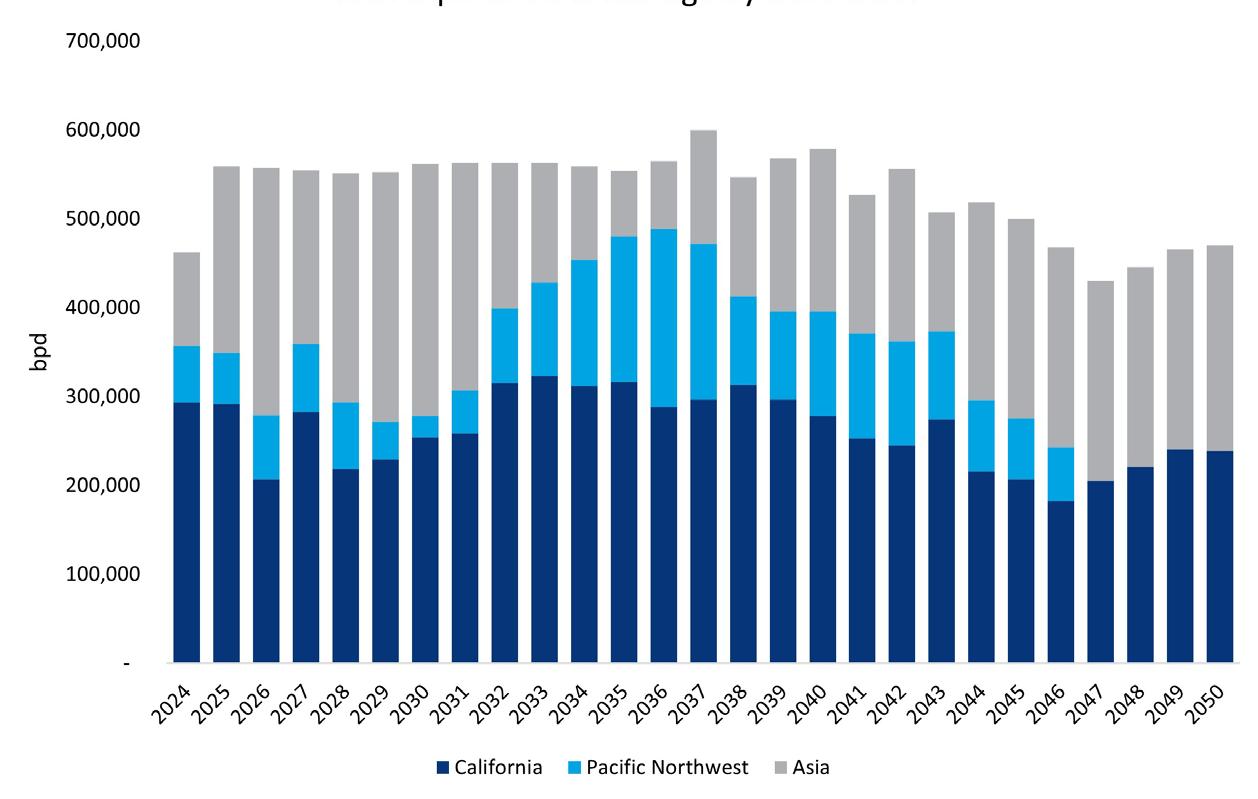
TMX: the answer to western Canadian egress pipeline constraints?
Fortunately for western Canadian oil companies, relief is on the horizon. We expect the Trans Mountain expansion project
(TMX) to enter service and boost regional egress capacity in 1Q24. This timeline is supported by our construction reconnaissance and company guidance. The capacity of the Trans Mountain system – which flows southwest from Edmonton, Alberta, to Vancouver, British Columbia – will increase from 300 000 to 890 000 bpd once the expansion is complete.7
We expect TMX to immediately be highly utilised amid strong pull from Pacific Basin demand centres (namely refineries in the US West Coast and Asia), even as available space materialises for broader WCSB takeaway.3 We expect TMX’s start-up will temporarily lead to slight declines in eastbound western Canada egress utilisation (including mainline) through the middle of the decade, before Canadian supply growth again fills expanded pipeline capacity through the decade and eventually pushes the marginal barrel to rail once more in the 2030s.3
Despite our forecast including another cycle of western Canadian takeaway constraints, we expect TMX will be the last major pipeline investment in the region.3 The regulatory landscape has proven extremely unsupportive of Canadian pipeline developments. Additionally, we forecast future pipeline constraints to be relatively short-lived, with eventual production declines leading to available capacity by the mid2030s.
‘The times they are a-changin’ for North America’s crude oil pipelines
Bob Dylan may not have had midstream operators in mind when he wrote about change, but that doesn’t change the fact that North America’s crude oil pipelines have had to constantly evolve through the years to keep up with the industry’s rapid evolution. We see this change continuing in the form of a final wave of midstream investments in the middle of this decade to facilitate peak North American production.
In our forecast, continued production growth in both the Permian Basin and Canadian oilsands will push pipeline takeaway capacity utilisation to uncomfortably high levels, further necessitating capacity expansions as we’ve seen in the past. Additionally, while pessimistic forward-looking views on crude production and recent increased capital restraint may limit the extent of potential capacity expansions, the industry will once again have to turn and face the strain of ch-changes.
References
1. www.tshaonline.org/handbook/entries/permian
2. www.woodmac.com/industry/oil-and-gas/midstream/macro-oils-service
3. www.woodmac.com/industry/oil-and-gas/oils-refining-ngls/north-americacrude-markets-service
4. www.woodmac.com/industry/oil-and-gas/oils-refining-ngls/us-gulf-coastpipelines-report
5. www.enbridge.com/projects-and-infrastructure/public-awareness/ minnesota-projects/line-3-replacement-project
6. www.woodmac.com/industry/oil-and-gas/oils-refining-ngls/canadianpipeline-service
7. www.transmountain.com/project-overview
Inline inspection (ILI) has been utilised to help manage corrosion threats in pipelines for decades, and throughout that time has been actively developing and maturing. Magnetic flux leakage continues to be the most widely and arguably effective inspection technology employed by pipeline operators to manage corrosion, and while there have been significant advances in sensor density and electronic capabilities, what will not change is that it is an indirect measurement technique. This means that it relies on ‘truth data’ to calibrate or train algorithms to interpret the signals and provide the meaningful data needed to assess pipeline condition.
In parallel, there have been advancements in the quantity and quality of validation or truth data being collected. Historically, a relatively low volume of artificially created or machined defects were used as truth data to calibrate the inspection systems. Today, high quality and high-resolution depth measurements can be collected by pipeline operators which can provide hundreds or even thousands of measurements of individual corrosion features from a single dig. Combine that across thousands of inspections and there is exponentially more truth data available that can be used to feed data hungry machine learning (ML) algorithms that could step change inspection tool measurements.
Seeing this emerging opportunity and working closely with customers keen to advance inspection system performance, Baker Hughes has established its ‘big data’ library. It is a vast database of high quality, field measured, truth data, aligned together with the highest resolution inspection signals and operational data that is ideally suited to explore these new opportunities arising with advanced data analytics techniques.
As a first application of the data library, Baker Hughes wanted to look closer at the reported tool tolerances of the tools with the aim of removing conservatism in dig programmes while at the same time improving pipeline safety. Why

was this important? Well, even a small change in the reported tolerance of reported metal loss can have a significant impact on planned integrity management programmes and knowing when tolerances are more likely greater than expected will lead to earlier warning that pipeline repair may be needed.
Currently, and historically, metal loss tolerances are typically reported using seven metal loss categories defined by the Pipeline Operators Forum (POF) that subdivide metal loss by length and width (Figure 1).1 This methodology has provided benefit by allowing differentiation in reported tolerance relative to length and width, which can influence MFL sizing accuracy.
The POF-based categorisation does have some limitations though. First, with it being defined as discrete bins, there are potential step changes in reported tolerances as a reported anomaly transitions from one category to the next. This does not represent how the tolerance is truly affected by potentially subtle length and width changes. Secondly, length and width are not the only influencing factors
that can affect tool tolerances. Anyone who regularly works with the data will know that specifications are provided with a tolerance and confidence level which means reported results will generally be within specification but sometimes they are not. Accounting for this adds conservatism to the process of integrity assessment and therefore can ultimately lead to unnecessary costly repairs.
A research project was started in collaboration with TC Energy to explore if modern data analytics methods could be applied to the vast library of known corrosion measurements and associated signals to establish a way to move away from ‘binned’ tolerances based on dimensions with a generalised accuracy, to a specific tolerance that could be predicted based on the signal characteristics of an individual corrosion feature.
Line-specific tolerance prediction model
The initial stages of the research considered two pipelines with over 40 000 defects between them correlated to field laser measurements. Multiple influencing parameters were identified and investigated to evaluate correlations between the actual depth error and the anomaly parameters. By prioritising the influencing factors, four categories of parameters were nominated as input into the model training that had the highest impact on the sizing accuracy. Inputs that had little to no influence were excluded. The categories determined were:
) Predicted anomaly measurements: the predicted length, width and depth output of anomaly sizing models.
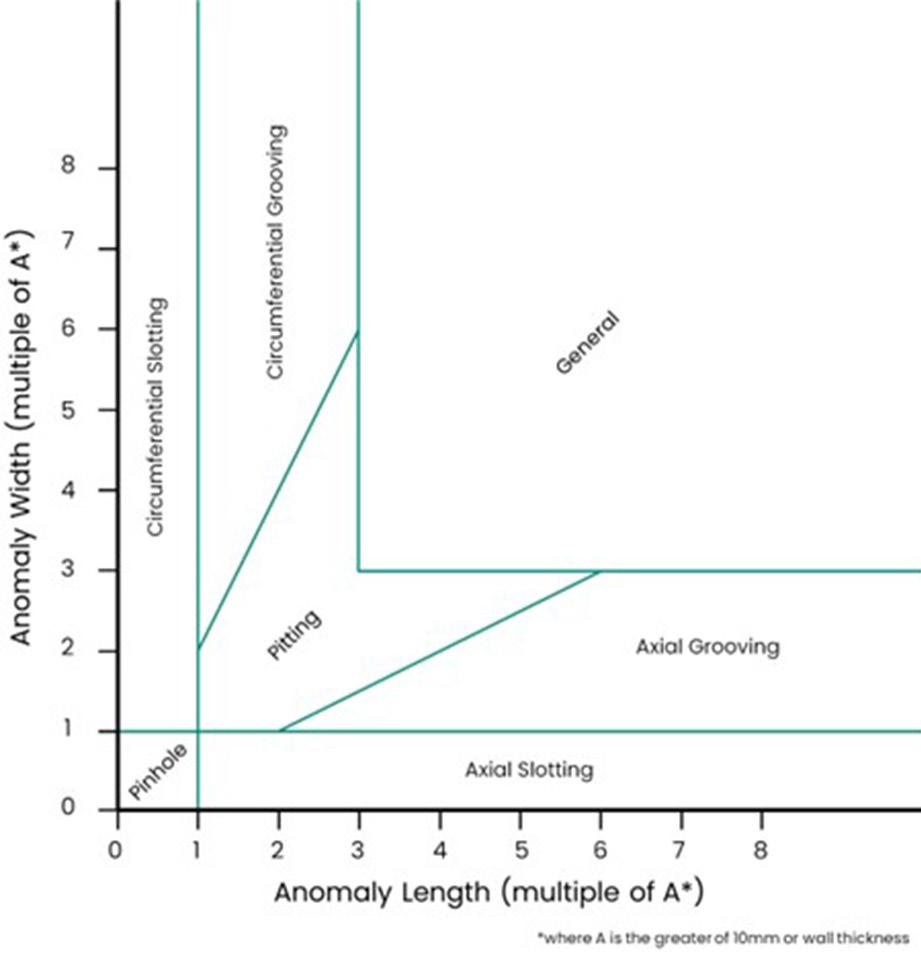
) Raw signal characteristics: the parameterisations of the anomaly ILI raw signal, including both the triaxial MFL data and other supplemental raw data.
) Location and interaction to other pipeline fittings and fixtures: the location and interaction of target anomalies to other pipeline fittings and fixtures. This includes items like tees, valves, bends, repairs, etc.
) Location and interaction to other defects: the location and interaction of target anomalies to other neighbouring anomalies.
Not surprisingly, the factors mentioned within these categories interact together in complex ways to influence confidence bounds and explain the variable sizing tolerances.
Utilising the prioritised importance of each influencing factor, a pipeline-specific ML model was trained and optimised on the truth data to predict a tolerance for each defect. This method was then expanded to eight additional pipelines with diameters ranging from 8 - 42 in. and included several hundred thousand anomalies between them, with a line-specific model being produced for each pipeline.
The percentage of defects that experienced a tightening of their tolerance bounds vs a widening, as compared to the POF-based tolerance, was examined on both the truth dataset and across the entire pipeline. Table 1 shows the
Once a pipeline is in production, debris within the system can be more extreme, with sand or scale or wax deposits. This can require more specialist pigs to be used, where designs are more focused and offer the ability to be adjusted as part of a progressive cleaning programme.
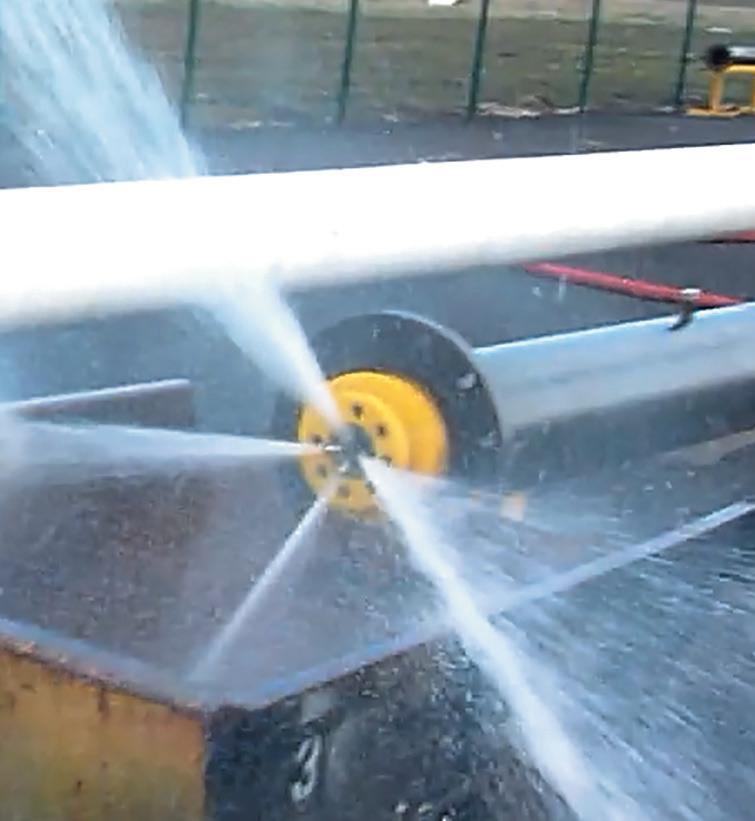

Propipe pigs are designed specifically for each pipeline and offer optimum performance to maintain maximum production pressures and flow.


Standard Pigs - No Bypass
Propipe Pigs with Bypass
Full testing facilities and the Trident pig tracking range are available.


percentage of anomalies in each line with a predicted tolerance improved compared to the POF-based tolerance.
A clear improvement to the tolerance value was observed on most defects, effectively removing the over-conservatism present in the POF-based published tool specification. However, not all predicted tolerances were made tighter, and some portion of defects had wider tolerances predicted. This was a crucial outcome in terms of safety as the wider predicted tolerances in these cases more accurately represent the likely tolerances associated with them.
Potential benefit to integrity programmes
For each of the lines in the study, TC Energy applied their probabilistic growth model utilising the predicted tolerances, and compared the results against those utilising the POFbased tolerances to assess the theoretical impact. TC Energy evaluated the potential benefit of this new approach to tolerance specifications by looking at three key metrics of their integrity management programme; the number of digs over a 10 year growth period, the number of digs prior to the next re-inspection date, and the next ILI re-inspection year.
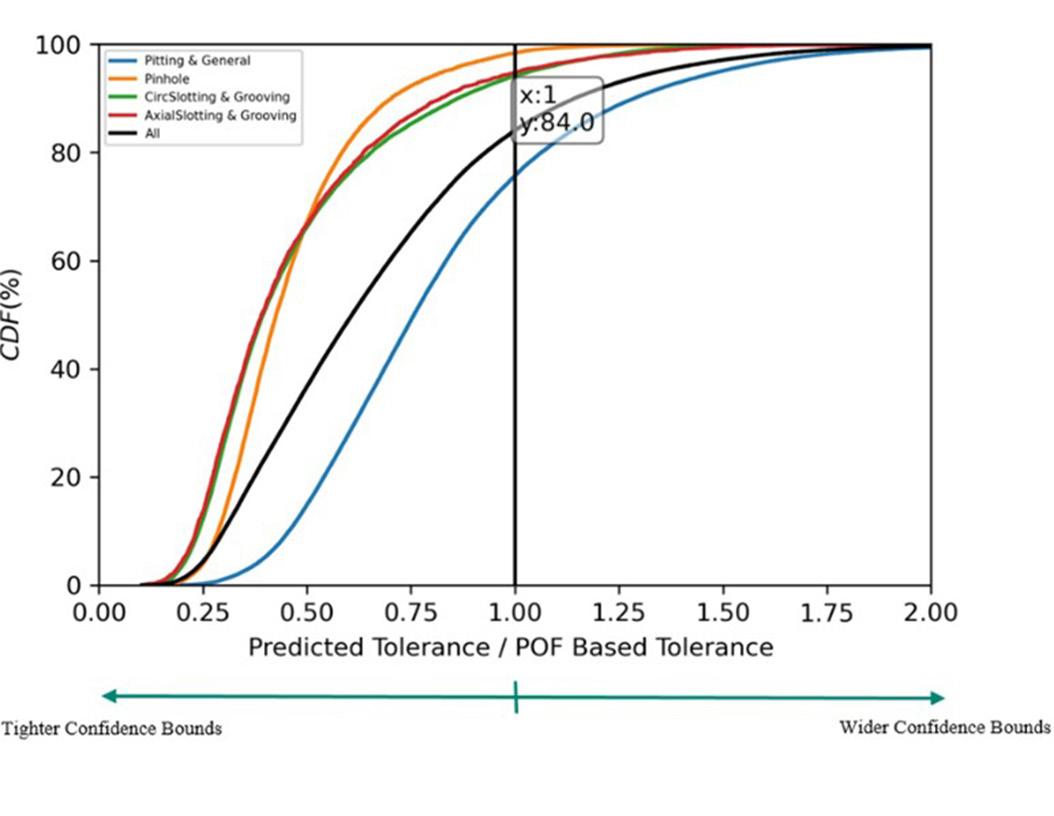
Projecting through a 10 year growth period, it was found that the majority of the lines would require fewer digs when using the predicted tolerances than would have been required using the POF-based tolerances. One line had an increase in the number of digs required, and another line showed no change. Overall, across all lines there was a total of 593 fewer digs required: a 29% reduction.
Looking at the shorter, more realistic timeline, the change in the required number of digs before the next re-inspection year was examined. In this case, two lines were found to have an increase in the number of digs required, two lines had no change, and four lines had a reduction. Overall, there were 23 fewer digs required: a 62% reduction.
Lastly, the recommended year for the next inspection was reassessed. Here, it was found that two of the lines could defer their re-inspection by one year, with another line by up to three years, when the predicted tolerances were used compared to the POF-based tolerances. In addition to the benefit of the dig count and re-inspection year, TC Energy’s analysis involved an assessment of safety which included reviewing field data to confirm that all critical defects were identified when employing the model predicted tolerances. This investigation found no safety concerns when utilising the predicted tolerances in lieu of the POFbased specification.
Generic tolerance prediction model
The potential benefits to overall dig effectiveness identified in the initial phase of this project when considering a pipelinespecific tolerance predictor model naturally led us to investigate whether we could broaden the approach to be able to build a model that could predict the tolerance of an anomaly generically, i.e. on any feature, in any line of appropriate type.
In the next phase of this project, a generic ML model was developed using an expanded dataset of hundreds of thousands of anomalies reported by Baker Hughes MFL tools similarly matched to field measurements. Figure 2 represents
 Figure 2. Depth distribution of correlated field data.
Figure 2. Depth distribution of correlated field data.
the extent and distribution of the data used to train the model data. The model generated an anomaly-specific depth tolerance prediction with similar improvements to the previous phase results.
Model performance and assessment
Normally ILI sizing accuracy is specified in terms of error confidence bounds at a defined confidence (typically 80%). To illustrate model performance, in Figure 4 two plots are shown – the one on the left shows the target results for the actual metal loss depth error compared to the predicted tolerance values (referred to as a confidence plot), and the one on the right shows the actual error values plotted against the predicted tolerance for 80% confidence bound for a representative sample of data. The plot shows a spread of data points in horizontal and vertical directions. The horizontal spread indicates the absolute variation of the anomaly-specific tolerance prediction. The vertical spread increases linearly from left to right, following the two +/-45° lines (unity lines) and those defects that fall between the diagonal lines (non-shaded area) are within tolerance. The green points represent the anomaly-specific predicted tolerance in comparison to the red points that represent the original POF-based tolerances. The plot allows validation that the predicted tolerances are meeting the expected targets, that the error ranges are reduced, and that the predictions are generally less conservative – but not always.
Visually, comparison of the POF-based tolerance to the new anomaly-specific predicted tolerance can be seen in Figure 4. To quantify the gains provided by the developed approach over the existing POF-based tolerances, however, the ratio between the POF-based and the predicted bounds across all the defects and subgroups based on POF-categories are calculated, and a cumulative distribution function (CDF) plot is used to illustrate the population trends of these ratios. In Figure 3, the x axis shows the ratio of the new predicted error bounds and the existing POFbased bounds (both at 80% confidence), and the x:1 line indicates where the predicted tolerance bounds, and the current POF-based tolerances are equal. The plot allows immediate identification of median gains, quartiles, and min/max value, as well as what fraction of all the anomalies have tighter predicted confidence bounds than POF-based bounds.
In general, the plot shows the improvement of the model predicted tolerances over the current POF-based specification by tightening the confidence bounds for majority of anomalies. In Figure 3, for example, 84% of all anomalies improved. However, wider error bounds than POF-based bounds were predicted for some of the anomalies which, as stated before, point to an important outcome for the project. The model provides the more accurate and realistic prediction of the anomaly’s actual tolerance, which would be beneficial to pipeline safety since the anomaly’s risk will be more accurately assessed and can therefore be addressed appropriately through an integrity management programme.
Repeatability assessment
As a further validation of model performance, it is important to understand the anomaly-specific tolerance prediction is repeatable, since we are using multiple parameters as inputs to the model. This is a measure of how much variation in the predicted tolerance is expected if the same set of anomalies were measured multiple times. To approximate the evaluation repeatability, a line with

two ILIs by Baker Hughes was considered. A detailed signal level comparison of two sets of magnetic flux leakage data was completed by RunComTM and the identified matched anomalies considered for the repeatability study; there were more than 350 000 matched anomalies in the targeted line. The repeatability distribution in change in predicted tolerance is shown in Figure 5.

Table 2 shows the anomaly-specific accuracy prediction repeatability at confidence intervals of 80% and 90%. The results determine the expected variation in the predicted tolerances, and approximates a repeatability assessment, but there could
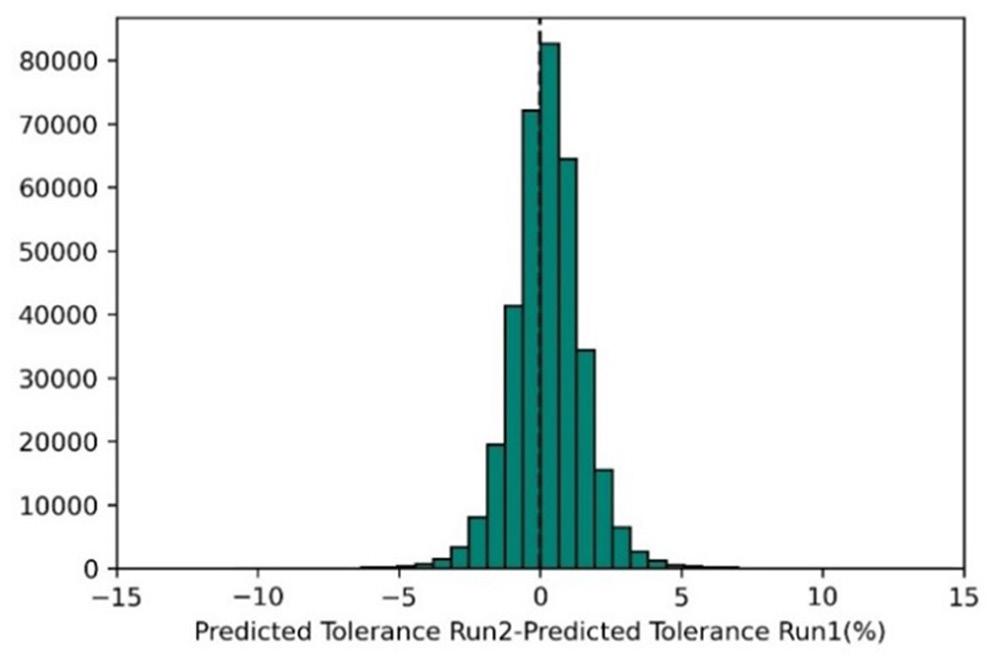
be some variation due to actual growth (change in corrosion characteristics) by utilising inspections separated by time as well as complexity of anomalies in the lines.
Conclusion
Existing methodologies to define MFL tolerance specifications have been effectively used for many years but with the relatively recent ability to collect high volumes of high accuracy data on true corrosion and advanced data science techniques. We now, however, have an ideal opportunity to re-think how inspection tolerances are defined based on vast statistical populations of truth data, and better understanding of the essential variables that influence measurement accuracy.
This project has demonstrated how latest generation analytics can be applied to materially change ILI tool performance understanding, which in turn can both reduce maintenance costs and improve safety, as well as how pipeline operators and inspection vendors can work collaboratively to challenge the norm and redefine how we approach integrity management.
Notes
Article based on a paper originally published in the proceedings of the 2023 Pipeline Pigging & Integrity Management Conference, organised by Clarion Technical Conferences [doi. org/10.52202/068696-0072]. Used with permission.
References
1. ‘Specifications and requirements for in-line inspection of pipelines’, Pipeline Operators Forum (November 2021).
2. CARIDAD, K., GURNEY, M., HUANG, T., HURD, G., MILLER, S., TSE, V., AND ZHANG, B., ‘Exceeding Performance Standards of Pipeline Inspection and Integrity with Advanced Data Analytics’, Clarion Technical Conferences and Great Southern Press (2022).
3. ‘In-line Inspection Systems Qualification’, API Standard 1163 (September 2021).
ipeline cleaning is of paramount importance to maximise the lifetime of the hugely expensive pipeline asset, minimise maintenance and energy costs, and consequently ensure maximum commercial returns to the operator. Unfortunately, history tells us that the design of piping systems has not considered the need for regular pipeline cleaning. This means that there has been no consideration for seamlessly introducing pipeline cleaning tools known as pigs into the pipeline, without stopping or interrupting production flow through the pig launcher. Similarly, the receiver must be designed to accommodate the removed debris, together with the emerging cleaning tool. This design fault may be based upon the common misconception that the pipeline may not
need cleaning, or that the design of launchers and receivers ‘appear to be simple pressure vessels’ that can be easily retrofitted if needed. Often, the planning, engineering and procurement of launchers and receivers is left to the last minute, or takes place years after production commences, with little thought of the function of the launchers/receivers over the lifetime of the pipeline system or the integration into the system.
There are lots of examples of ‘unpiggable pipelines’: pipelines designed and commissioned without any consideration for future cleaning or inspection. Once constructed, commissioned and supplied, their ongoing maintenance becomes the responsibility of others. Experience

Simon Bell, iNPIPE PRODUCTS, UK, describes the cassette arrangement, enabling multiple pigs to be loaded into a launching trap at any one time.
Successful launchingand receiving
has proven that the majority of cleaning problems could have been easily avoided had the cleaning systems been considered and designed with the same care as the pipeline itself. In simplistic terms, the design of the launchers and receivers should be dictated by the pigging frequency and types of cleaning pigs to be used, together with the intelligent pigs needed for periodic inspection of metal loss/potential failure modes. It should also be considered that the type of cleaning tools may change over a 25 year lifetime, or more. For example, some pipelines in the UK were originally constructed with an expected 25 year operational lifetime but are now over 50 years old and still profitably operating. Throughout extended pipeline operation, the type of deposition and amount of deposition may vary greatly, as the reserve product and rate of flow changes. This may mean that different types of cleaning tools will also be required: a gas pipeline may initially use spheres, which may lead to bi-directional pigs and, finally, as flowrate diminishes, there may be a requirement for bespoke low flow pigs to be designed. The one constant requirement over the course of the evolving pipeline is the need to design a pig launcher that can handle, load and launch different cleaning tools quickly and efficiently, and then to receive these tools together with varying amounts of debris, with minimal disruption to production.
Undoubtedly the successful financial operation of the pipeline over the commercial lifetime expectation is wholly dependent on the efficiency and frequency of the cleaning regime, which includes pig handling, and launching and receiving the pipeline cleaning tools (pigs) that travel the pipeline for cleaning, pipeline inspection or stabilisation
purposes. Entrusting the design of these vital systems to non-specialists, who often come with no practical, hands-on experience, armed only with a few proprietary catalogues, can be a short-sighted economy. This is particularly true as pipelines become larger, which can mean trying to remove hundreds of cubic metres of debris if not regularly cleaned.
Pig trap definitions
Pig launchers and receivers (often referred to as ‘traps’) can be referred to by many different names; some of which describe their nature and orientation, e.g. pig, scraper, vertical, inclined, declined, subsea or temporary.
Although the definitions are simple, in reality it is quite different, because a cleaning tool launcher or receiver is a pressure vessel that, when wrongly designed, badly manufactured, poorly maintained or incorrectly operated, can be the cause of operational problems. If the system design is not carefully considered and fool-proof to use, it may compromise the concept and simply not be used, which in itself will create a multitude of additional issues within the pipeline. Scale of size is also a significant variable in design, when it is considered that we are discussing launchers and receivers that accommodate tools from typically 2 - 120 in. in diameter and tools can vary in weight from a few kilos up to 8000 kg.
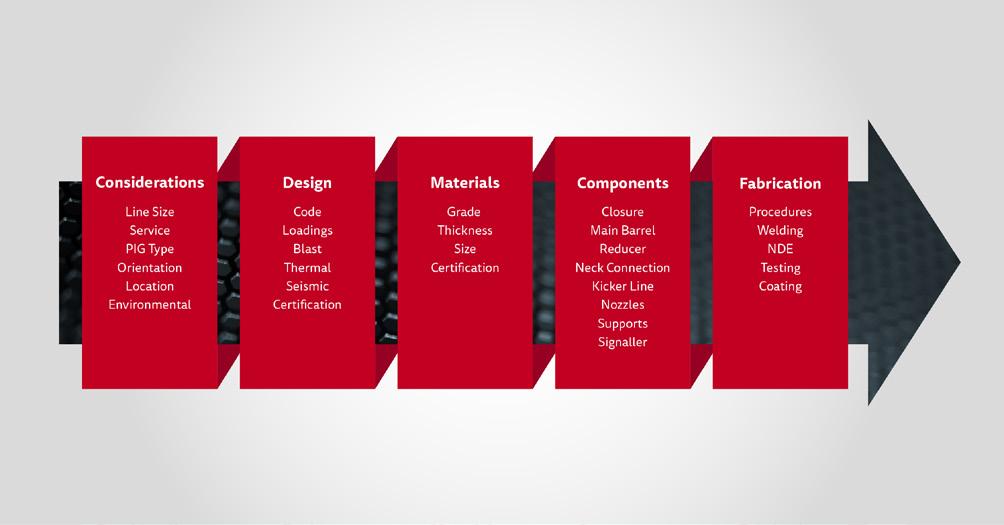

A more detailed definition of a pig trap is a pressure vessel designed with the following features necessary for safe operation:
) Provides safe access to or from a pipeline.
) Provides a means by which this access can be safely closed between the surroundings and full pressure capability of the pipeline – major oversized barrel for easy tool insertion.
) Provides for the access to be opened, or closed, with speed, convenience and safety – rapid opening closure.
) Provides an internal holding or storage position in which the cleaning tool may rest until desired travel movement is achieved, or after travel is terminated.
) Provides a means of converting the cleaning tool from its free expanded state into its compressed travelling state –reducer from the major barrel through to the minor barrel/ line pipe.
) Includes, or is associated with, the means of controlling flow, pressure and/or mechanical movement to give the cleaning tool a positive driving force into or out of the pipeline – valve system and kicker.
) Incorporates a properly engineered, safe and practical provision for connecting to the pipeline.
) Is properly supported in a way which will neither impose excessive strains on the pipeline nor will accept more force than it is safe or desirable from the pipeline and its associated systems.
Figure 1. Typical launcher arrangement drawing.
Existing launchers and receivers are generally designed to accommodate the launching of an online inspection tool. Inspection tools are considerably longer than a standard cup or disc pig; consequently the main barrel of the pig launcher is able to accommodate multiple numbers of standard pigs if required. Typically, four pigs are used, but any number can be accommodated dependent upon the pipeline profile and features that dictate the length of the pig. Historically, it has been standard practice to load and launch cleaning tools/pigs/ scrapers one at a time, but this is time-consuming and costly. Single loading and launching creates more wear and tear on the moving parts of the launcher and receiver – such as valves and closure doors – which leads to considerably more maintenance. In addition, the frequency of pigging may be dictated by remote or long-distance location, as in the case of remote, un-manned platforms or very long pipelines where it is costly and very time-consuming to deploy a number of technicians to carry out the operation.
Containment cassette
More recently, operators have begun reviewing the possibility of introducing the loading of multiple pigs through a cassette, and then sequentially launching one of four production pigs without significant modification to the launchers. The basis of the invention relates to development of a cassette designed and manufactured to the same size of the nominal barrel, with self-seals into the reducer in order to successfully launch/deploy a number of cleaning tools/pigs/scrapers, either one at a time or sequentially as required. This simple method negates the need for hot-work or significant modifications to the launcher, which may
have seen decades of use in the past.
The containment cassette is designed with a view to the location of cleaning tools and the method of release control. It uses existing nozzles located at various distances on the major barrel of the launching trap, dependant upon the required length of the cleaning pigs. Flow can be diverted through an actuated control system to actively feed each nozzle and each pig sequentially and as required. In this instance, a number of seals (between the internal cassette and the supply nozzle) need to be created using a ‘composite mushroom seal’ manufactured from a polymer material. Each driving nozzle requires a ‘polymer mushroom seal’. The initial driving force can be provided by the product itself, or by an addition of an interim propulsion, such as nitrogen gas, until such time as the pig reaches the main bypass line.
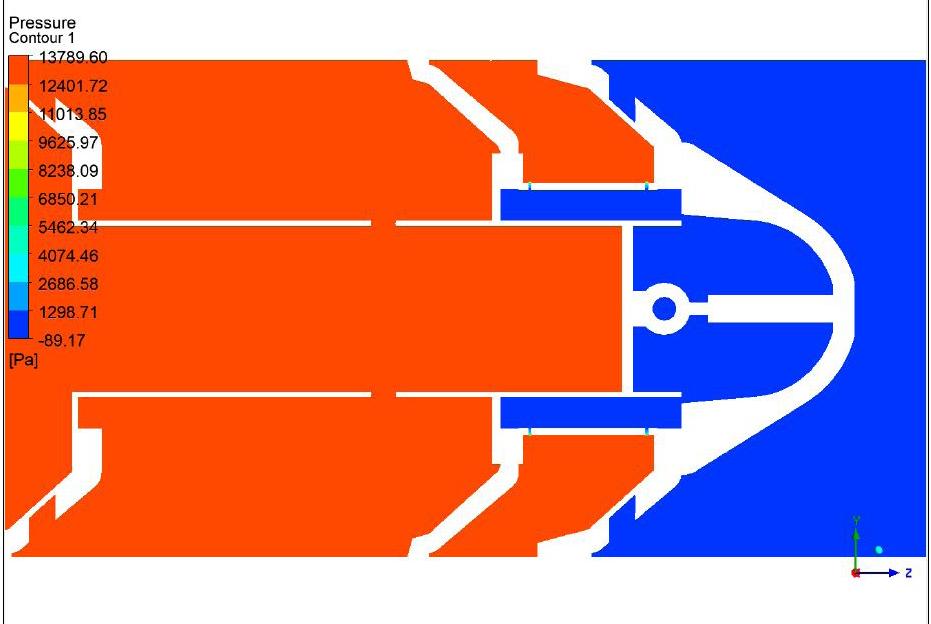
In addition, and in tandem to, full scale testing, CFD analysis was conducted to look at frictional factors, pipeline medium and pressure/flow.


The cassette arrangement enables multiple pigs to be loaded into the launching trap/cassette at any one time, and pigs can be launched in a controlled way from a remote location, i.e. a control room offsite. This is particularly useful when cleaning mature sections of pipeline servicing old or mature fields, which typically require more frequent pigging as output declines and they become more susceptible to low flow, and lower operating temperature with a higher water cut than originally expected. Due to the low flow there is an additional potential for more deposition of waxes, condensates, scale, SRB activity and other typical deposits.
Conclusion
By using the retrofitted automatic pigging solution, operators can increase the frequency of pigging without the additional costs normally associated with this activity. In addition to reduction in pigging costs associated with any cleaning operations, it also minimises the risk to personnel carrying out the operation, reduces potential wear and damage to the existing infrastructure (particularly on larger diameter pipelines where there is already significant wear/damage to all moving parts of the launching trap including valves, closure doors etc).

The NEW counterweight mounted M100W recovery winch is Midwestern’s latest innovation in excavator attachments. This system replaces the original counterweight, making productive use of what was literally dead weight. Advantages over mounting a winch on the track frame include greater ground clearance, and higher pull location to lift and pull at the same time. Other features include light and camera mounts, ladder and locking swingout doors, and additional storage. Make the most out of your excavator with a MIDWESTERN M100W winch.
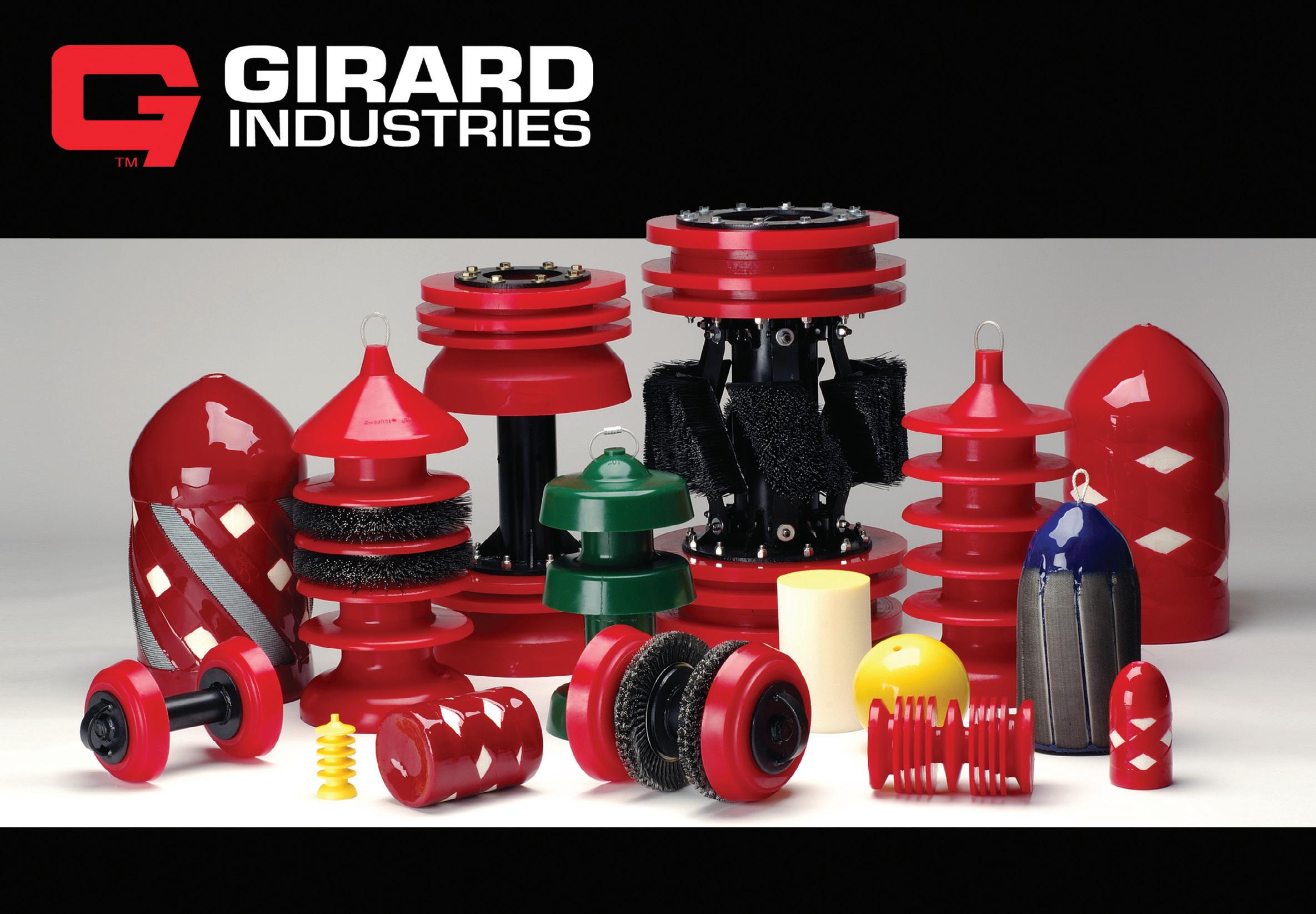


918-858-4201 I sidebooms.com

 100,000 lb Line Pull
100,000 lb Line Pull
Real-time offshore data

Asset life extension and the drive to avoid the need for early decommissioning is a huge focus area for operators. Commissioned initially to inspect a complicated riser for corrosion damage of the carrier and production pipe on an asset in the Gulf of Mexico, and which was running a pipe-in-pipe-in-pipe system, Tracerco deployed its market leading technology DiscoveryTM to undertake this primary focus of work.
Created to provide owner operators with an enhanced understanding of a pipeline, its coating and identification of any potential internal buildup – all whilst fully operational –Discovery has fast become the market leader deployed on assets across the globe.
Through the use of pioneering subsea CT scanning technology – commonly used for non-invasive medical
diagnostic techniques – and the very first of its type in the pipeline inspection industry, Discovery has changed pipeline inspection and maintenance by providing a technology that can inspect the integrity of multiple elements during one inspection process.
Additionally, it is this capability which enabled the world leading industrial technology company to identify two additional problems on the Gulf of Mexico asset, beyond the original scope of work, and which posed the risk of additional failures for the pipe-in-pipe-in-pipe system.
These included identifying a significant vibration and heavy movement on the gas lift riser, coupled with a possible annulus integrity breach. Exposing another potential failure mechanism, the identification of the gas lift riser vibration indicated the need to conduct a series of vibration analysis to
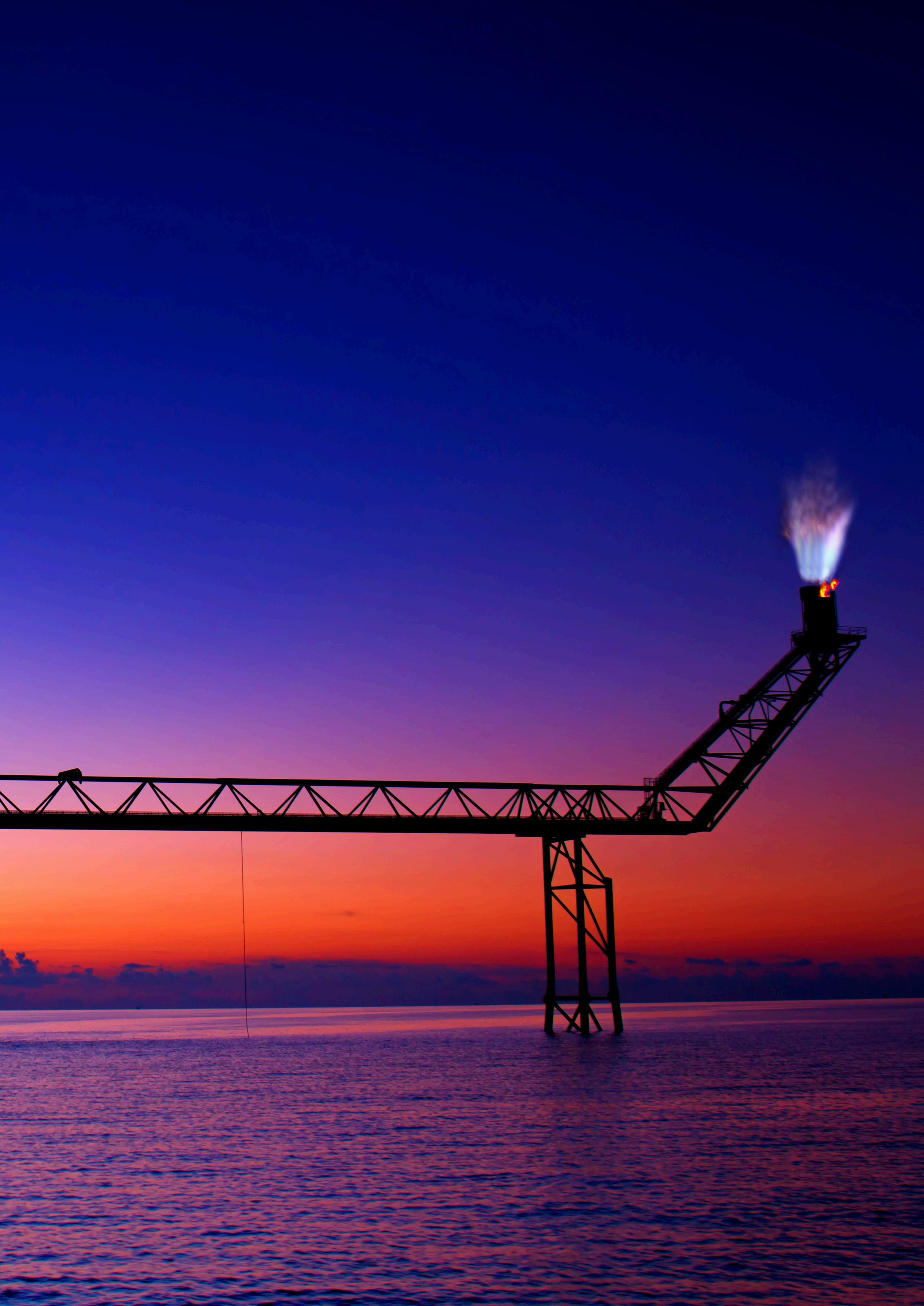
JimBramlett, Commercial Manager, Tracerco, the Americas, talks through the distinct operational advantages of choosing the right subsea pipeline inspection technology.
prevent and mitigate fatigue issues that were previously never considered.
Identifying the possible integrity breach in the annulus – the reliability of which is vital to pipe-in-pipe systems – also enabled Tracerco to provide valuable insight to the customer, advising on further studies and scanning that should be conducted. Using Discovery technology, this included measuring the density of the annulus, plotting any changes in this density with water depth and – where any breach was identified – using this technology to detect the location with pinpoint accuracy.


‘There really is no other technology in the market that can deliver all this insight in one scan,” comments Jim Bramlett. “Yes, there are other technologies which might have found the vibration issue, but not in the same inspection or scan. The value of Discovery is that there really is no inspection technology that could have provided the integrity information on all pipes; have seen the gas lift riser; identified any potential flow assurance concerns (buildup on pipe walls) or have verified the integrity of the annulus all in one single technology; at the same time and all whilst fully operational.”
For Tracerco, this technology is also underpinned by the advantages of real-time offshore data, enabling customers to immediately modify their scope of work should that be required.
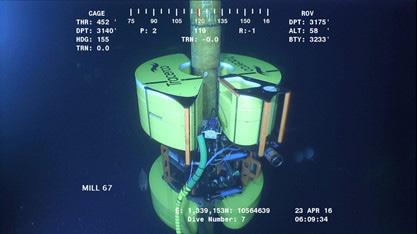
“One of the real values of Discovery is the real-time data”, added Jim. “The availability of this means our customers can make instant decisions based on factual and real-time evidence. The high-level advantage of getting that real-time data means if we find more challenges, we can adjust the scope of work whilst our teams are offshore and complete the inspection for our customers instead of demobilising. Because it’s real-time, we’re in the field and this data can be seen, our customers have the option to do additional stationary monitoring and act quickly, implementing solutions and taking on board recommendations. The efficiencies of this are huge, saving customers significant time and money.”
Another value add that Tracerco provides while on board is that we can handle pipes ranging in size from 6 - 26.5 in. total outside diameter. This again allows for Tracerco to adapt offshore to any additional scanning that the customer may want to add during the inspections. In the pre-job planning with our customers, we encourage the inclusion of both the integrity personnel along with the flow assurance personnel to review the entire scope of work. We know that potential flow assurance issue may not manifest in the same location that potential corrosion issue will. This allows for capturing valuable insight for both groups during a single inspection.
Industry leading technology
Pioneers of this type of technology, Tracerco’s Discovery has provided the industry with a unique and innovative methodology that enables the online inspection of a pipe from the outside
Figure 1. Inner gas lift riser found to have high frequency vibration during the inspection of the production pipe (middle). Figure 2. Good section of pipe-in-pipe showing no wall loss features and well centralised.without the need to remove the protective coating or interfere with production.










Perhaps most importantly, Tracerco’s team is solely focused on this technology and developing key innovations around it, carving the business an unrivalled position as having the most highly skilled industry experts in subsea CT scanning. Discovery is a proven success globally with many of the leading oil and gas operators deploying the technology across assets worldwide. The Discovery teams have been involved with this technology from conception to tool build, initial qualifications and deployments. This ensures our clients are truly getting the best subsea CT inspection and the people most qualified to handle project challenges.
Providing critical flow assurance and integrity data without the need for coating removal and all in real-time, the technology provides accurate sizing of wall thickness in minutes by taking a highresolution image of the pipe wall provided from an external scan of the pipeline. This tomographic image then identifies, with pinpoint precision, any wall loss flaws within the pipe walls, location, amount and density of any material or deposits, all within a single scan.
Discovery is deployed seamlessly via an ROV and clamped onto the pipe; it has been utilised across a wide variety of pipeline designs, investigating both internal and external corrosion, locating blockages, and identifying flow assurance issues. It is the only technology of its type to have been externally verified and field proven.
Having received Lloyd’s Register recognition, Discovery presents the technology for deepwater pipeline maintenance, a solution for those pipelines that cannot be inspected by conventional means. Additionally, it delivers an alternative where operators want to eradicate intrusion and loss of production from ILI pigging, delivering savings of up to 35% on the cost of inspection campaigns, compared with conventional scanning techniques. Combined with Tracerco’s inbuilt fast scanning technology, which reduces overall scan time by up to 80%, operators across the globe are benefiting from maximum data capture never before available in the market, and from one single inspection technology.
To date, Discovery has successfully gathered valuable data across tens of thousands of scans, enabling operators to refine and improve the efficiency of existing pipeline models.
A commitment to innovation
With a pedigree in innovation and a number of first to market technologies, Tracerco is firmly committed to continued research and development on its industry-leading technology suite. To date – and based on the previous case study – the business has been commissioned by several operators to monitor annulus integrity, and is currently the only provider in the marketplace with this capability coupled with the other aspects Discovery can cover.

Discovery continues to be developed with the introduction of fast screening, baselines scans, corrosion analysis and continued development to enhance identification of buildup/ blockages such as asphaltenes, sand, hydrate and wax.

he Pipeline Industries Guild is excited to introduce a new approach it is developing to support its members and partners with devising net-zero capabilities. This is chiefly in relation to pipeline development and collaborating with partners to generate the tools to support industry best practice, and ultimately to help tackle our global climate emergency.
If you haven’t already heard of us, the Pipeline Industries Guild is a globally renowned association that brings together professionals and companies involved in the pipeline industry regardless of sector. With a rich history dating back to its establishment in 1957, the Guild has been instrumental in fostering collaboration, knowledge sharing, and advancement in the pipeline sector. We are excited to introduce a new approach we are developing to support our members and partners with devising net-zero capabilities in relation to pipeline development.
The Guild brings together a diverse range of individuals, including engineers, technicians, academics, contractors, and suppliers, creating a vibrant community that shares a common goal of advancing pipeline-related technologies, practices, and sustainable development within the industry.
Within the UK and Ireland, the Pipeline Industries Guild has established branches further expanding its influence and impact. These branches serve as regional hubs for members, offering localised support, networking opportunities, and industry-specific insights. Each branch organises regular events, seminars, and technical visits, tailored to specific needs and challenges. By fostering a strong presence at a regional level, the Guild ensures that it remains responsive to the diverse requirements of its members, while also providing a unified voice for the industry on a global scale.
The Guild’s branches and technical panels champion international collaboration with strategic partners, local institutions, universities, and research organisations to promote education and professional development within the pipeline sector. Through the Professional Development Network Panel, they encourage young professionals to join the industry and provide them with the necessary tools and resources to thrive. Furthermore, the Guild’s panels engage with regulatory bodies and government agencies to advocate for policies and regulations that support safe and sustainable pipeline operations.
The Net Zero Transition Panel

As the world increasingly focuses on reducing greenhouse gas emissions to help reduce the damage to our planet’s environment, the pipeline industry has a critical role to play in enabling the transition towards a net-zero economy. The Guild has played a pivotal role in addressing the pressing issue of climate change and recognises this responsibility. The recently formed Net Zero Transition Panel provides a platform for industry professionals to discuss and implement sustainable practices, share case studies, and explore innovative solutions for reducing the industries carbon footprint.
The UK, alongside many other countries, is embarking on and underway with a large-scale energy transition change programme. Complex by its nature, its breadth, and our UK timeframe of reaching net-zero by 2050, it requires industry, academia, governments, and investors to collaborate, be aligned and conduct timely decision-making alongside advancement and implementation of innovative technologies and solutions.
There is a critical need to prepare and plan for the models that underpin the investment case for future low carbon gases, says the Pipeline Industries Guild’s Net Zero Transition Panel.

The Guild recognises its position of strength to harness and provide valuable contributions and play its role across multiple sectors within the pipeline industry to support our members, wider stakeholders, and the UK in its transition to low carbon energy solutions. This new Net Zero Energy Transition Panel has been introduced this year to the structure of the Guild.
Initially, the panel will apply its focus to five core lenses, with a new online hub scheduled to launch later this year as a central library and reference area for members to access netzero content. The five panel focus lens areas are:
) Regulation and investment.
) Innovation.
) Health and safety.
) Skills and competence.
) Net-zero construction.
The panel has intentionally created a diverse membership cross-industry and across the value chain, including network operators, designers, constructors, land specialists, and small and medium-sized enterprises. It’s important for the Guild and the panel that we remain neutral, facilitate, discuss, and share multiple viewpoints, research and developments across all methods and means to transition our energy system effectively.
To do this, we are utilising existing networks, working groups and communities to complement each other and remove duplication of effort. All sectors within the pipeline industry are at various stages within the net-zero transition lifecycle; if we can use these cross-sector networks and communities to share valuable lessons learned, the positive impact will be far reaching. If one thing is certain about the energy transition, it’s that it requires a paradigm shift from how we generate, transport, and use energy today.
The future energy mix requires far more viable scalable options for differing usage and demands that provides energy security through resilience for the UK and beyond. This cannot be achieved by industry, academia, governments, and investment institutions being misaligned or working in isolation.
Our five lenses:
Regulation and investment
Martin Shannon, Head of Commercial Services, Cadent. There is a critical need to prepare and plan for the models that underpin the investment case for future low carbon gases such as hydrogen and biomethane, and to further develop the business and regulatory models that will deliver a thriving low carbon energy economy by 2030. Hydrogen and biomethane offer low-carbon gas solutions that will be critical for the UK’s transition to net-zero.
As part of a deeply decarbonised, deeply renewable energy system of the near future, low-carbon hydrogen will be a versatile replacement for high-carbon fuels used today –
helping to reduce emissions in vital UK industrial sectors and providing flexible energy for power, heat, and transport.
The UK’s vision, resources and know-how are ideally suited to rapidly developing a thriving hydrogen economy, as well as exploring other means to utilise low carbon gases like biomethane to help us transition away from the use of natural gas. The UK’s Hydrogen Strategy will drive progress in the 2020s to deliver 5 GW of hydrogen production by 2030, and position hydrogen to help meet the UK’s Sixth Carbon Budget and netzero commitments.
Innovation
Dr.KateYoung,DirectorStrategicConsulting,Jacobs. The innovation lens is focused on making it easier for members to draw on the broad and diverse membership to sharpen ideas, share successes and lessons learned to de-risk development, to learn from each other so that we can collaborate and accelerate scaling.
The scale and pace required to meet our net-zero goals requires a step change in delivery across all pipeline sectors; learning from sectors with more mature legislation, regulation, and systems to accelerate the development of emerging sectors and leveraging emerging and nascent sectors to challenge the accepted and established practices of the more mature, well-established sectors.
Innovation is naturally risky, but with pipelines providing essential services to our communities and businesses, we don’t have the luxury of stopping or slowing down provision whilst we trial and scale solutions.
Health and safety
AdamKnight,ProjectDirector,Cadent.
Through the health and safety lens of this panel, we review a critical element of the management and implementation of future pipeline industry infrastructure. This is key for our net-zero transition panel, with the focus being on safe transportation and storage of new gases. There will be a need to devise and future-proof ways of working as we look to safely introduce new gases to our networks and for storage – this will include gases such as hydrogen and biomethane. Additionally, this will require close working with regulators, like the HSE, to ensure that compliance is planned and programmed into all processes and that due diligence is undertaken to support the safe supply of new gases, which may have different characteristics to methane and therefore require adjusted management for safe delivery, transportation, and storage.
Skills and competence
RutaBlazeviciute,ManagingDirector,SkewbClimate. Innovation and achievement of an energy transition to netzero means the pipeline industry must re-skill the existing workforce to adapt to new technologies and processes, as well as introduce new green jobs to create assets and infrastructure to enable the long-term energy system to support a net-zero future.
Organisations in the pipeline industry must, in the next decade, prioritise building the necessary skills and
WHEN YOU ADVERTISE
Everyone wants t o get what they paid for. World P ipelines is independently verified by ABC, because we want our advertisers to know they're getting the exposure they've been promised.




ABC. See it. Believe it. Trust it. To advertise email Chris Lethbridge at chris.lethbridge@worldpipelines.com or Daniel Farr at daniel.farr@worldpipelines.com






ADVERTISERS’ DIRECTORY
competencies to drive this transition. They must also implement training and development programmes that focus on new technologies and processes, in order to decarbonise and digitise the energy system, such as renewable energy, carbon capture and storage, and green gas, including hydrogen and biomethane. These programmes should seek to attract and excite new talent, create roles which support young people to follow their values like protecting our planet, and represent the diversity of the communities our industry serves.
Let’s be clear, we are in a global race for these skills and to achieve net-zero goals, this will require the industry to come together with a clear and focused plan to create these skills over the next decade.
Net-zero construction
NathanReidDirectorofAppliedEngineering,Murphy&Sons Ltd.
Leading the net-zero construction lens, J. Murphy & Sons Ltd have over 75 years’ experience of major infrastructure projects, and are now recognised as a leading global specialist engineering and construction EPC Partner, offering FEED, detailed design, and installation and commissioning. Their energy sector also has a wealth of experience, delivering strategic pipelines, and energy transition infrastructure projects within the UK, Ireland, and Canada.
The Murphy integrated design and construction teams ensure buildability is integrated throughout the design process, embrace innovative ways of working, and support our delivery to harness greater efficiency, sustainable delivery, and enhanced net-zero construction, across energy transition projects and the full asset lifecycle. By harnessing this approach, they not only offer significant value-add options, but make our operations safer and give greater delivery certainty.
As a key player in reducing their carbon footprint, they continue to work towards a more inclusive and sustainable future to support our planet, the communities they work in, and each other. Their focus is on sustained growth, innovation, and operational efficiency, and they have set ambitious and transparent targets to become net-zero by 2030; they are working in collaboration with the Guild and the panel to a detailed roadmap to get us there.
Conclusion
In conclusion, the Pipeline Industries Guild is an esteemed membership organisation that serves as a catalyst for progress and collaboration within the pipeline industry. Through its international panel, it facilitates global knowledge exchange, enabling professionals to address common challenges and embrace emerging opportunities.
The Guild’s commitment to the net-zero transition and the introduction of this new panel highlights its dedication to a sustainable future, while its branches ensure a strong regional presence and support for members wherever they operate. By bringing together industry stakeholders, the Pipeline Industries Guild continues to highlight innovation, promote best practices, and connect people.



ARGUS PIG VALVE


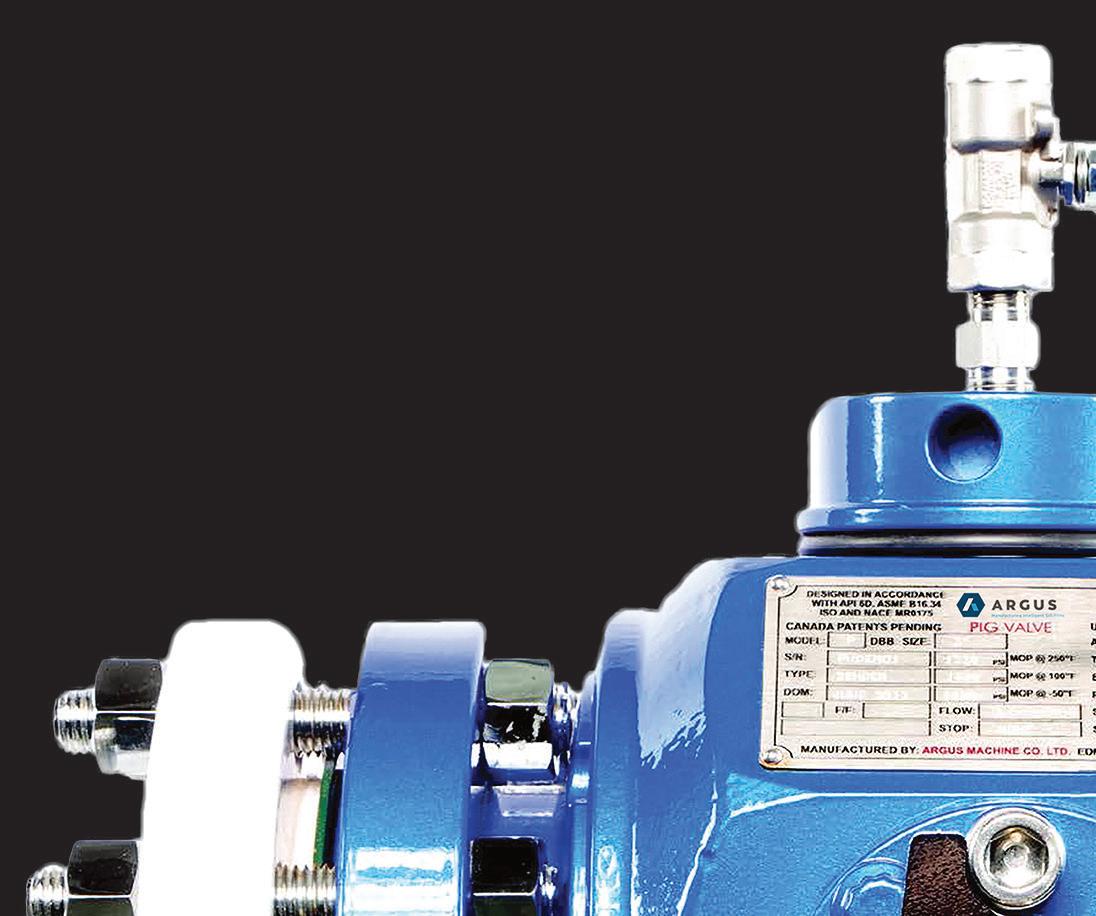
Optimize Every Line





